When growing plants at home, the location is obviously one of the most vital factors you need to consider.
For example, if you are placing your plant in (or near) a south-facing window, your plant will get plenty of sunshine.
If you are placing it in (or near) a north-facing window, however, your plant will barely get any direct sunshine.
Plants in west-facing windows receive a half-day of direct sunlight. They receive most of that direct sunlight during afternoons rather than morning time.
Now, what about plants in (or near) east-facing windows?
Well, the light conditions in east-facing windows are actually pretty similar to west-facing windows in that plants will receive a half-day of direct light in that location.
But unlike in west-facing windows, plants in east-facing windows will get that portion of direct sunlight in the morning rather than in the evening.
Remember the saying: “The Sun rises in the east”? You surely do!
Now that we got the theory out of the way, let’s see which plants do best in east-facing windows!
Best Plants for East-Facing Windows
- Angel Wing Begonia
- Chamaedorea elegans (Parlor palm)
- Chamaerops humilis (European fan palm)
- Columnea gloriosa (Goldfish plant)
- Cordyline fruticosa (Hawaiian Ti plant)
- Cliva miniata
- Dieffenbachia (Dumb Cane)
- Dracaena fragrans (Corn plant)
- Ficus Elastica (Rubber Tree)
- Ficus Lyrata (Fiddle-leaf fig)
- Peperomia metallica
- Pilea cadierei (Aluminium plant)
- Schefflera elegantissima (False aralia)
- Solenostemon scutellarioides (Coleus)
- Zamia pumila (Coontie)
- Calathea Orbifolia
- Areca Palm
- Prayer or Maranta Plant
- Watermelon Peperomia
- Polka Dot Plant
- Youth on Age
- Purple Shamrock
- Boston Fern
- Croton Plants
- Japanese Aralia
- Wax Begonia
- Chinese Money Plant
- Philodendron Pink Princess
- Monstera adansonii
- Rose Grape
- Jade Plant
- Peace Lilies
- Moth Orchid
- Norfolk Island Pine
- Peony
- Aechmea Fasciata
- Calico Plant
- Caladium
- Grape Ivy
- Azaleas
- Campanula
- Soft Tip Yucca
- African Violets
- Cyanotis Kewensis
- Cissus Striata
- PocketBook Plant
- Cast Iron Plant
- Fire Flash
- Baby’s Tears Plant
- Rainbow Vine
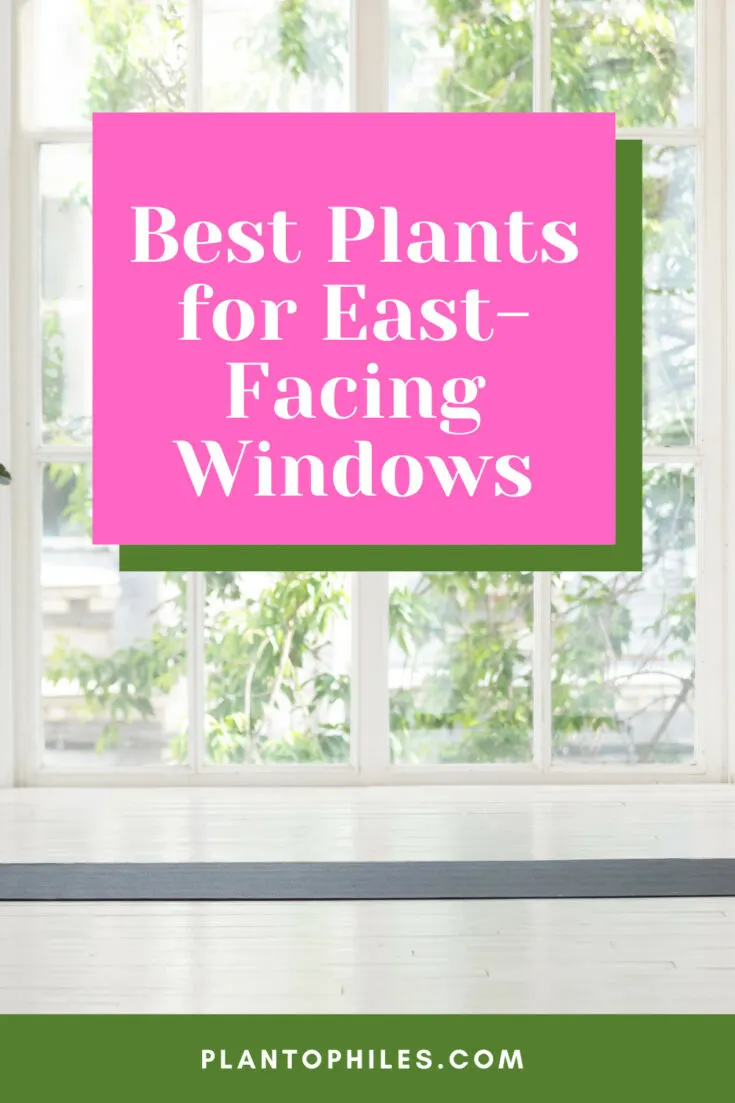
Best Plants for East-Facing Windows
50 Best Plants for East-Facing Windows
1. Angel Wing Begonia
![50 Best Plants for East-Facing Windows [2024] 1](https://plantophiles.com/wp-content/uploads/2020/08/East-Facing-Window-Plant_-Angel-Wing-Begonia.png.webp)
Angel Wing Begonias are a specific group of Begonia cultivars. These plants are very well-known and there are various cultivars – hundreds even – out there.
One of our favorite cultivars is the Begonia Maculata.
Now, as far as light conditions go, angel wing begonias generally do best in medium light.
As they can’t tolerate direct sunlight and as they do prefer colder morning light, they do very well in (or near) east-facing windows.
As direct sunlight even from an east-facing window is likely to burn their foliage, make sure to use sheer curtains to block the direct sunlight.
2. Chamaedorea elegans (Parlor palm)
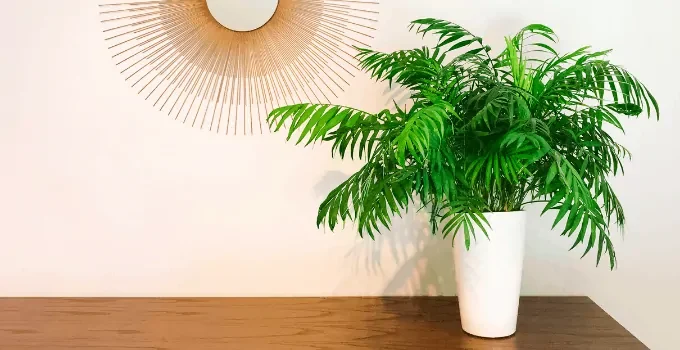
While some plants are extremely hardy and can tolerate different levels of light, some others are very particular with regards to how much light they are getting.
And just because your plant seems to survive, that doesn’t mean that you have found the perfect location for it just yet.
Now, as far as Chamaedorea elegans, also Parlor palm, goes, it feels most comfortable either near an east-facing window.
The Parlor palm will also thrive well in a west-facing window, though, as in that location, it will also receive a half-day of full sun (in the afternoon rather than in the morning.
Lighting for plants is a pretty complex topic. And the vocabulary that comes with it, is something pretty hard to understand. But please don’t worry about it, Plantophiles got you covered.
Just take a gander at our extensive guide on light levels and you will be up-to-date.
3. Chamaerops humilis (European fan palm)
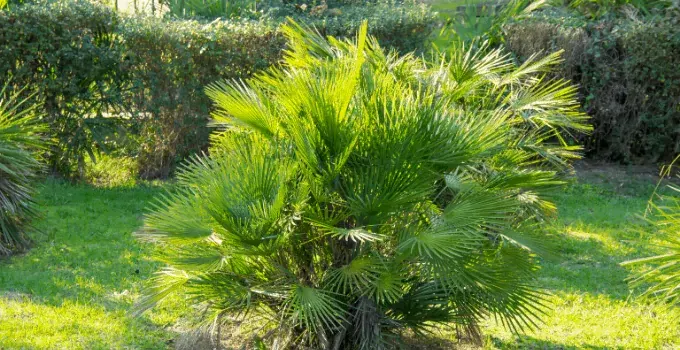
European fan palms like a couple of hours of direct sunlight each and every day. This is what makes them a great houseplant for east-facing, as this will enable them to get a half-day of full sun (afternoon).
With that much sunlight, you would probably think that your European fan palm would grow very quickly, but that is actually not the case. This palm does indeed grow very slowly when grown as a houseplant. So don’t worry about that.
As palms love a good deal of sunlight, you could even place your palm near a south-facing window (south-facing windows get the highest amount of sunlight from all windows).
If you do so, however, make sure to filter the light with the help of a curtain or the leaves of your palm might get sunburned.
4. Columnea gloriosa (Goldfish plant)
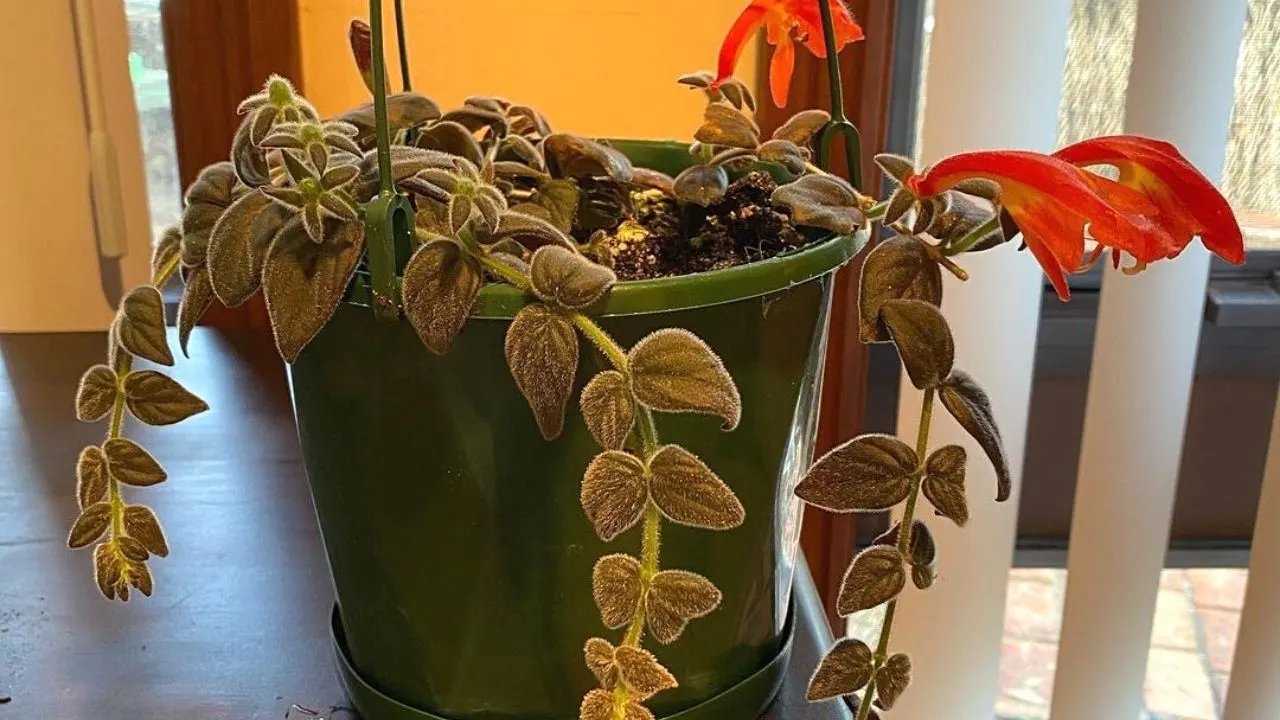
Photo Credit: @strawberriesandmoss on Instagram!
A quick glance at Columnea gloriosa is sure to reveal why it is actually called “Goldfish plant.”
Yes, the flowers of this extraordinary plant actually do resemble real goldfish, which is pretty amazing in its own right.
And, what’s best is that these plants will indeed bloom, even when grown as houseplants.
But in order for that to happen, you will need to make sure that your Goldfish plant care is on point.
As always, it is very important to provide your plant with an adequate amount of sunshine. For plants, sunshine is like food. And you absolutely need to make sure your Goldfish plant is not starving!
So, as far as light goes, your Columnea gloriosa fancies an east-facing window where it can get a half-day of full sun; in this location, your Goldfish plant is likely to unfold its true potential!
But please don’t forget: There’s much more that goes into proper plant care than just finding the right location for your plant.
You will also need to be careful about other aspects of plant care such as choosing the right soil, feeding your plant with fertilizer and conducting a regular and adequate watering schedule.
As difficult as this might sound, there’s not much to worry about for you, as we have crafted an in-depth article about Goldfish plant care. It won’t hurt to give it a go!
5. Cordyline fruticosa (Hawaiian Ti plant)
![50 Best Plants for East-Facing Windows [2024] 2](https://plantophiles.com/wp-content/uploads/2020/08/East-Facing-Window-Plant-Cordyline-Fruticosa.png.webp)
The Hawaiian Ti plant, as you could probably guess, is a tropical plant.
Tropical plants generally like a good deal of sunlight but can’t usually handle a lot of full sun (direct sunlight). A south-facing window without curtains would, therefore, would be a very bad spot for most tropical plants, as they would receive far too much direct sun.
With the help of curtains, though, even a south-facing window could get the job done, as this would eliminate the direct sun.
Still, there are better options as far as the location of a Hawaiian ti plant goes:
As a tropical plant, the Hawaiian ti can indeed handle at least a couple hours of full-sun, they are good friends with either west-facing or east-facing windows.
6. Clivia (Clivia miniata)
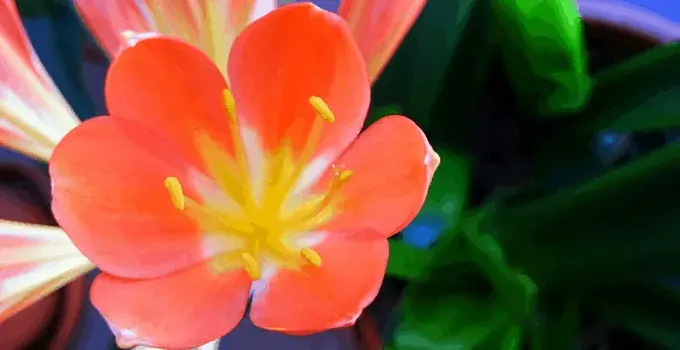
Clivia miniata is one of these plants that can easily be grown indoors as well as outdoors.
In fact, the best way to successfully grow Clivia miniata would be to keep them indoors in winter and then to move them outdoors (late fall to spring).
When kept indoors (winter time), an east-facing window that provides your plant with moderate light is your best bet. A
As Clivia does not like very hot temperatures, it prefers sitting in an east-facing window where it gets a half-day of full in the morning rather than being exposed to a half-day of full sun in the afternoon (= when placed in a west-facing window).
7. Dieffenbachia (Dumb Cane)
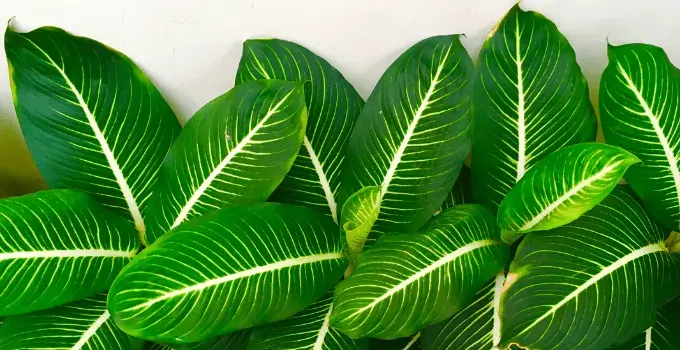
Dieffenbachia’s care is not all that difficult. You’ll easily get the hang of it. A quick glance in our Dieffenbachia plant care article will definitely be sufficient.
As far as sunlight goes, you have two choices with Dieffenbachia. Either you are going with window facing west or with a window facing the east side.
In both cases, you will want to have some curtains between your Dumb cane and your window, as direct sunlight is not good for your Dieffenbachia.
Dumb canes are really easy to grow. Even if you don’t have space near an east- or west-facing window, your plant is likely to survive.
You could also place it near a north-facing window and it would most likely still be fine, as it generally even tolerates low light conditions.
8. Dracaena fragrans (Corn plant)
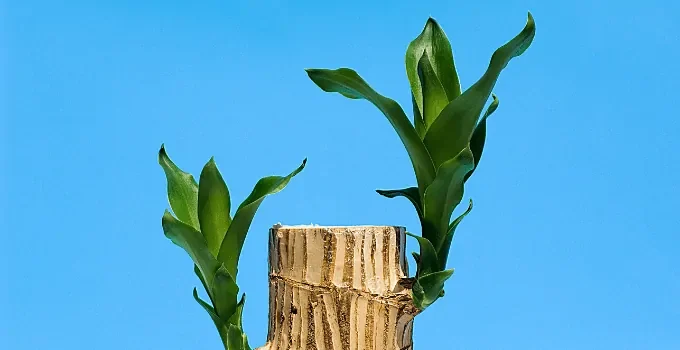
Dracaena fragrans enjoys a lot of popularity as a houseplant these days and is happily grown by plant parents from all around the world.
Dracaena fragrans, which also goes by the name of Corn plant, is yet another plant that thrives in bright, indirect sunlight. But on top of that, it also likes a good amount of full sun, which makes it the perfect candidate for an east-facing window.
As west-facing windows provide pretty similar light conditions (with the biggest difference being that west-facing windows receive a half-day of full sun in the morning rather than in the evening), a west-facing window is actually yet another good choice for this plant.
Medium light conditions as in these two windows are definitely best for this plant.
But that said, these plants are capable of surviving in low light or high light (when placed in a south-window). But survive and thrive are not exactly the same thing. So you should definitely go with either a west- or an east-facing window.
9. Ficus Elastica (Rubber tree)
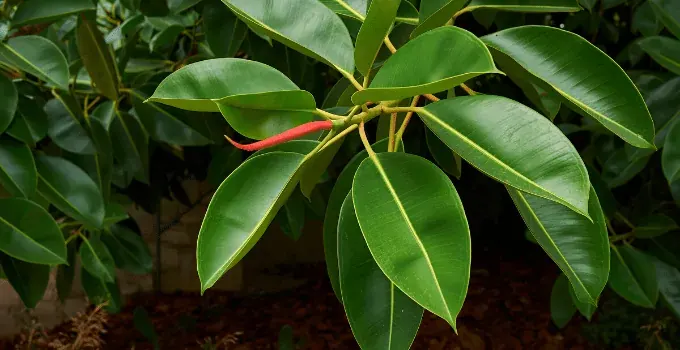
It is of utmost importance that your houseplants get the right amount of light. But what it the right amount of light, after all?
Well, it really all depends on your plant. Some plants thrive in low-light conditions, while others only thrive in lots of direct sunlight (this is true for many succulents and cacti).
So, what about Ficus elastica? How much light does your Rubber plant need to be happy?
Bright yet indirect light is the best for Ficus elastica. This makes it a great plant for an east-facing window.
If you do have a variegated Ficus elastica (god, they are so beautiful!), please be aware that they need some more sunlight than their regular counterpart.
This generally holds true for all variegated plants; they welcome more sunlight than their non-variegated friends.
In fact, if you are placing your Ficus Elastica near an east-facing window, the exact amount of light your plant is getting can still be adjusted. The general rule of thumb is that the closer you place your plant to the window, the more light it is getting.
That said, you can easily reduce the amount of light your plant is getting by simply moving your plant further away from the window.
10. Ficus Lyrata (Fiddle-leaf fig)
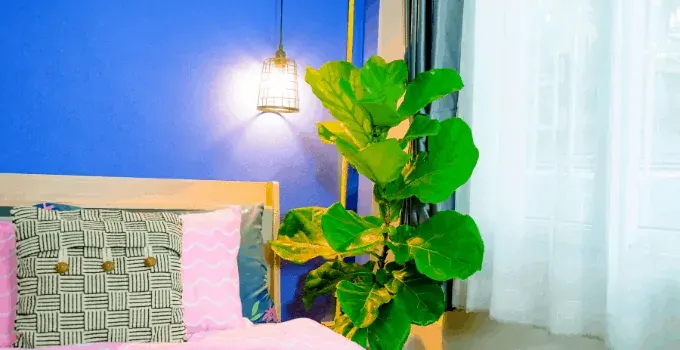
Fiddle-leaf figs are not easy to care for. There are various factors that can go wrong with Fiddle-leaf fig care.
The most vital aspect of Fiddle-leaf care is proper lighting. Make sure that your FLF gets an adequate amount of sunlight.
So, what’s adequate for a Fiddle-leaf fig?
These plants like a lot of sunlight. Bright, filtered sunlight is best for your FLF. And they also benefit from a few hours of direct sun each and every day.
So, this is why Ficus lyrata (the botanical name of the Fiddle-leaf fig) is a perfect plant for east-facing windows.
You should avoid dim light conditions at all cost, as this will have a very negative impact on your plant’s health and will most likely result in stunted growth of your plant.
As mentioned earlier on, Fiddle-leaf fig care is pretty tricky. This is why you should absolutely give our Fiddle-leaf fig care article a go to make sure that your care is on point.
11. Peperomia metallica (Radiator plant)
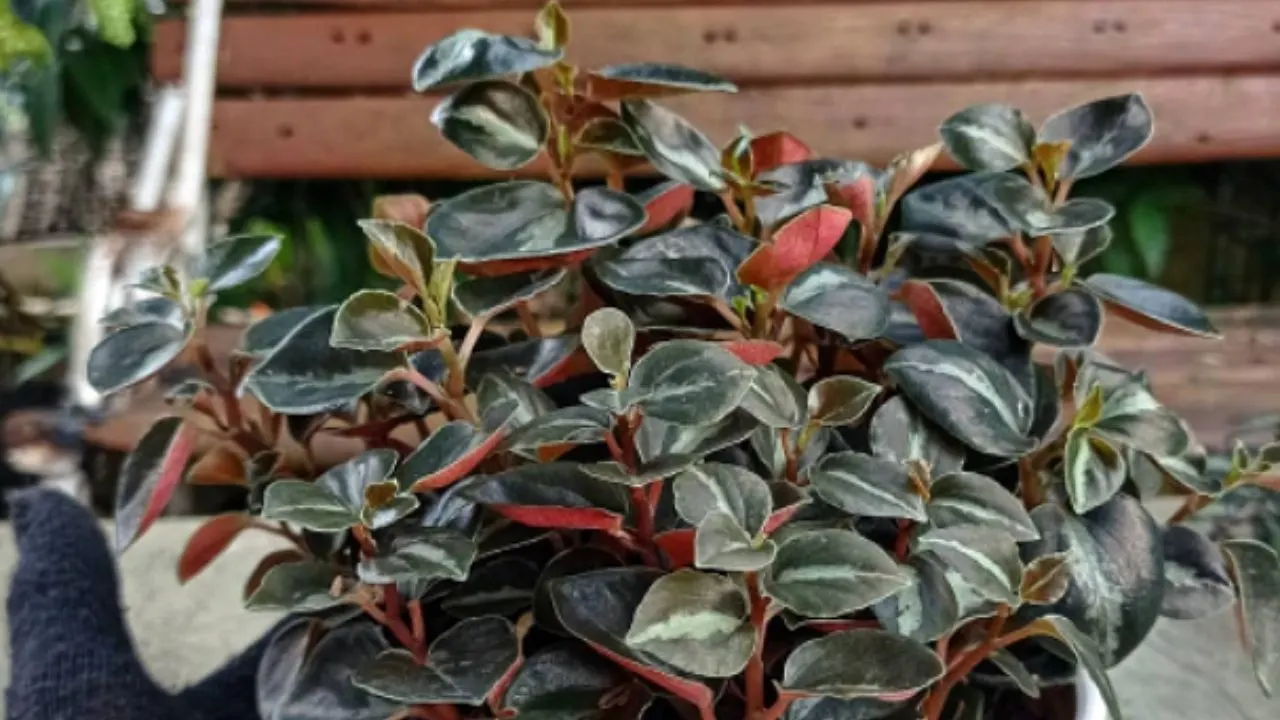
Photo Credit: @tamanhippie on Instagram!
Peperomias are lovely little plants that are enjoyed by many plant parents from all around the globe. With 1600 species to choose from, you are sure to find the peperomia that you always dreamt of.
While obviously not all of these species are popularly grown as houseplants, there are quite a few species that made their way in people’s homes and living rooms.
Here are some of our favorites:
Another Peperomia species that we are really fond of here at Plantophiles is Peperomia metallica, aka the Radiator plant. This species features dark-green, metallic leaves with red-colored undersides.
While there are many different variations & cultivars of Peperomia metallica, they generally do best in medium light conditions.
Bright, filtered light (=curtains are a must!) from an east-facing window is a great choice for most of these Peperomias.
If you do own a highly variegated Peperomia metallica, a couple hours of direct sunlight should be fine, too.
If you own a non-variegated type (=green leaves), then you should definitely keep them out of direct sun.
Also, if you can’t find a suitable location near an-east facing window, you could very well grow this plant under artificial lights. Peperomias, in general, do very well under artificial lights.
12. Pilea cadierei (Watermelon pilea)
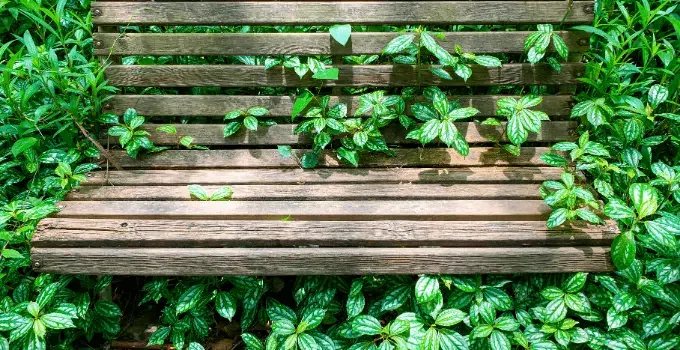
Pilea cadierei, also commonly known as either Watermelon pilea or Aluminium plant, is yet another houseplant that is a big fan of bright, indirect light.
However, this plant can’t tolerate direct sunlight, so directly placing it in either a west- or east-facing window without any curtains won’t do this plant well.
But an east-facing window is still an ideal spot for this plant; just make sure to put a sheer curtain between your Aluminium plant and your east-facing window and you are all set. Your Pilea cadierei will now receive exactly what it needs: Bright, filtered light.
If you happen to choose a west-facing window rather than an east-facing one, then you would also need to make use of a curtain because direct sunlight will burn the foliage of this beautiful plant. You definitely don’t want that!
In case you got any cats at home, it is good to know that Pilea cadierei is absolutely cat-safe.
13. Schefflera elegantissima (False aralia)
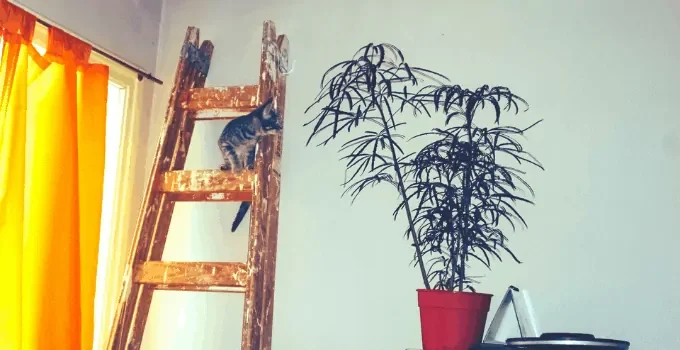
An east-facing window is a good choice for a Schefflera elegantissima, as it enjoys medium light conditions where it can get bright, filtered light.
To make sure that your False aralia does not get any direct sunlight, place a sheer curtain between your plant and your east-facing window.
Is it that easy? Not exactly.
How much light your False aralia is ACTUALLY getting when placed in or near an east-facing window, depends on various factors.
First of all, every window is different. While some windows are very small, some people have huge windows (lucky you!). The size of the window obviously has a drastic impact on how much sunlight your plant will finally get.
Then, how far away you put your plant from that window also defines and regulates the light intensity.
It only sounds logical that if you place your False aralia very close to the window that it will get more sunlight than when you put it further away from it.
So, where exactly should you position your False aralia?
Well, I wish it would be that easy.
As we have pointed out, an east-facing window is definitely a good starting point. But you’d need some experimenting to do to find out the perfect spot for it, still.
You could start with putting the plant very close to the east-facing window (curtains are a must though, please don’t forget that, as this plant can’t tolerate direct sunlight!).
Then, if you do feel that your plant still gets too much sunlight (scorched leaves are a sign of that), then you could gradually move it a little bit further away from that window.
Also, if you would like to actually measure the light intensity, you could download a light meter on your phone.
An application like this will help you to understand how much light your plant is actually getting (this won’t be super accurate either but might help you to make better decisions).
14. Solenostemon scutellarioides (Coleus)
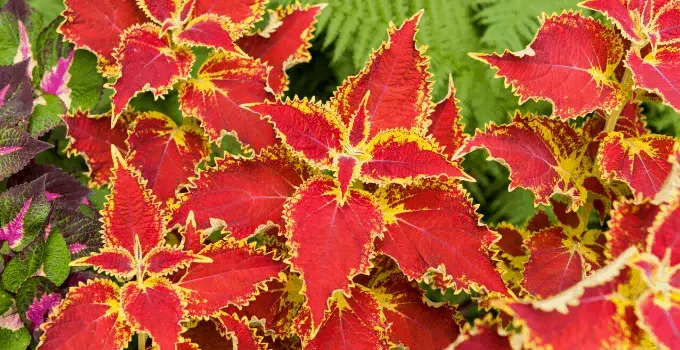
Coleus produces flowers. But this is definitely not the reason why this plant is so popular among houseplant enthusiasts from all over the world.
The truly spectacular thing about Coleus plants is their foliage. If you are into very colorful foliage, you can’t go wrong with Coleus.
The same also holds true for Crotons, though.
But let us now talk about the ideal lighting conditions for Coleus.
This plant prefers bright but filtered light.
You can either place it near an east-facing or west-facing window. It won’t tolerate direct sun, therefore you need to hang some curtains between your Coleus and the window.
15. Zamia pumila (Coontie)
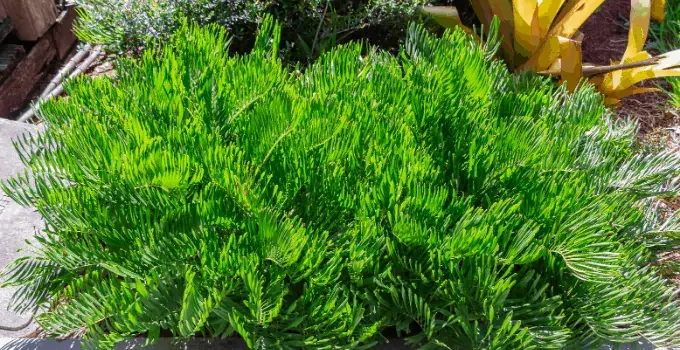
Coonties are very hardy plants. No matter if you grow them outdoors or indoors, these plants are considered low-maintenance and are not likely to give you all too many problems.
Moreover, Coonties grow very slowly. It is, therefore, important that you provide them with ideal light conditions so that they can at least grow a bit (with plants, not enough sunlight often results in slow or stunted growth).
Whereas Coonties can survive in all kinds of light conditions (ranging from low light to high light), they are known to do best in medium light conditions.
While they do enjoy a lot of sunlight (even a south-facing window is an option), they won’t be happy to receive too much direct sunlight.
Hence, you’ll need to provide them with filtered light.
While this might sound difficult, it is actually really easy: Just hang a curtain between your east-facing window and your Coontie and your Zamila pumila will receive exactly what it likes best: Bright, filtered light.
16. Calathea Orbifolia

Calathea Orbifolia is native to Bolivia and closely resembles the prayer plants in terms of looks.
It has large, ruffled leaves in lush green with silver markings giving it an intricate look.
Every plant owner needs this statement plant in their collection. This fussy plant is not for new gardeners.
- Family: Marantaceae
- Other names: Rattlesnake plant, Goeppertia Insignis
- Toxicity: safe for pets and humans
- Lighting: medium to bright filtered sunlight (8-10 hours)
- Temperature: 65 to 75 degrees Fahrenheit (18 to 24 degrees Celsius)
- Soil: combine peat, coco coir with perlite for good drainage
- pH: acidic (5.0-6.0)
- Fertilizer: use complete houseplant fertilizer once a month during active growth
- Growth rate: moderate
- Humidity: medium to high air moisture levels
17. Areca Palm
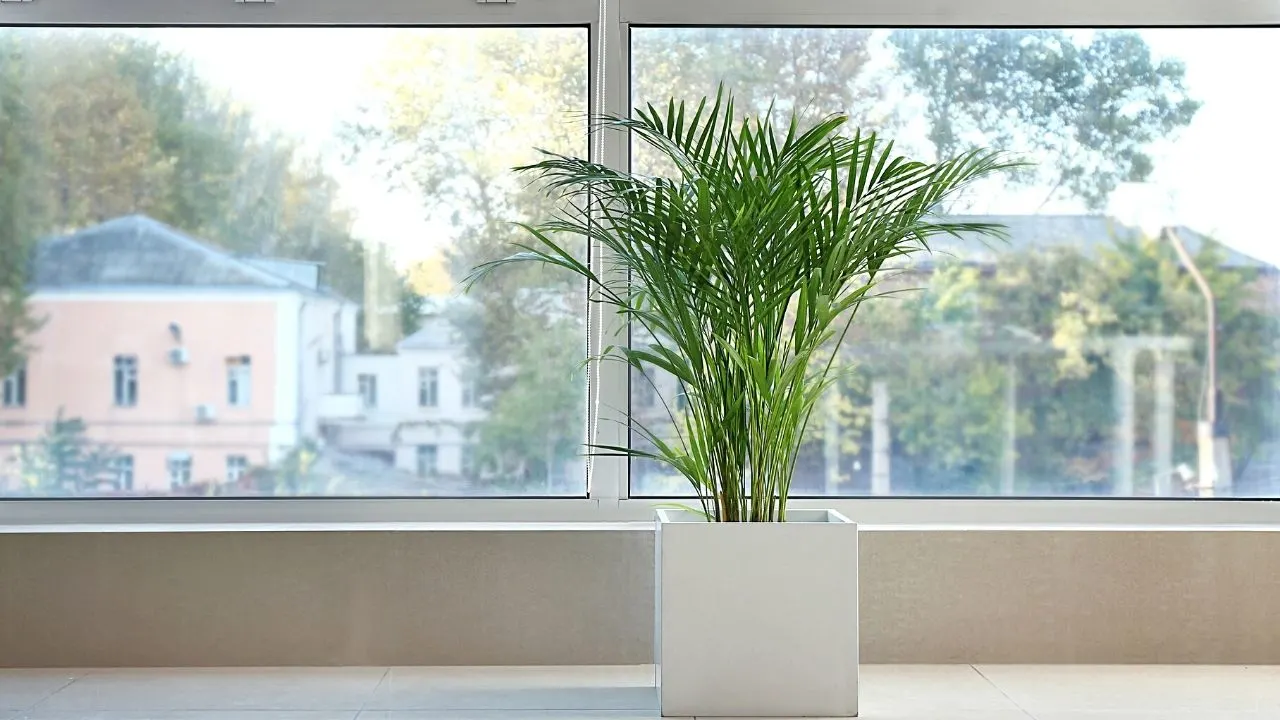
This endangered variety will introduce a tropical vibe to your indoor spaces. This variety resembles a bamboo plant, and the narrow fronds need protection from extreme heat or cold near the window.
The Areca palm requires a rich soil mix and regular feeding since it’s a heavy feeder.
Watch out for root rot, as this variety is sensitive to overwatering.
- Family: Arecaceae
- Other names: Dypsis Lutescens, Yellow or Golden Cane Palm
- Toxicity: non-toxic for pets and humans
- Lighting: filtered or full sun
- Temperature: 65 to 75 degrees Fahrenheit (18 to 24 degrees Celsius)
- Soil: a peat-based soil mix amended with sand
- pH: 6.1-6.5
- Fertilizer: spring through autumn using liquid plant food
- Growth rate: slow or moderate
- Humidity: 40% or above
18. Prayer or Maranta Plant
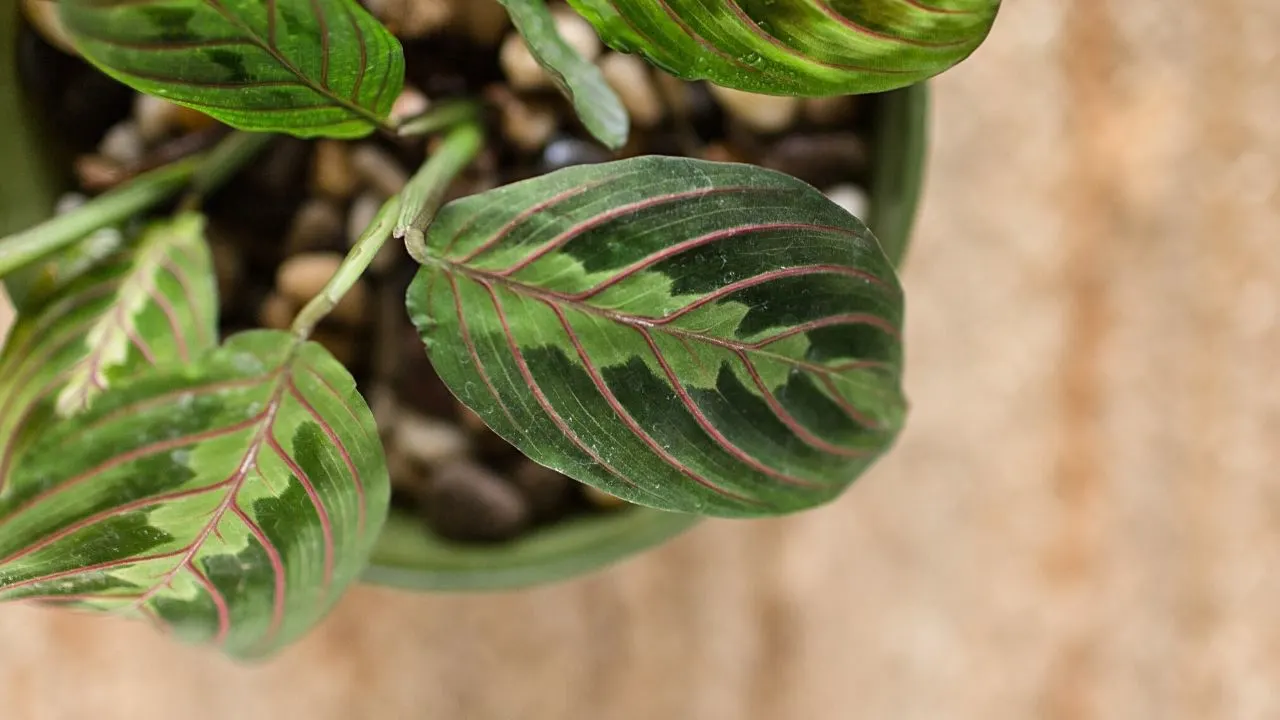
The decorative, oval leaves of the Prayer plant will add an exotic touch to your home. This Brazilian native will thrive in tropical environments.
This low-growing variety reaches a maximum height of 1 ft, so it’s a great pick if you are looking for an interesting plant to keep on the windowsill.
Although several varieties are available for indoor gardening, the tricolor varieties are highly recommended by most gardeners.
- Family: Marantaceae
- Other names: Maranta Leuconeura
- Toxicity: non-toxic
- Lighting: Partial or full shade
- Temperature: 60 to 80 degrees Fahrenheit (15 to 27 degrees Celsius)
- Soil: loamy soil with peat moss and perlite
- pH: 5.5-6.0
- Fertilizer: twice a month during active growth and once a month during dormancy
- Growth rate: slow grower
- Humidity: moderate, around 60%
19. Watermelon Peperomia
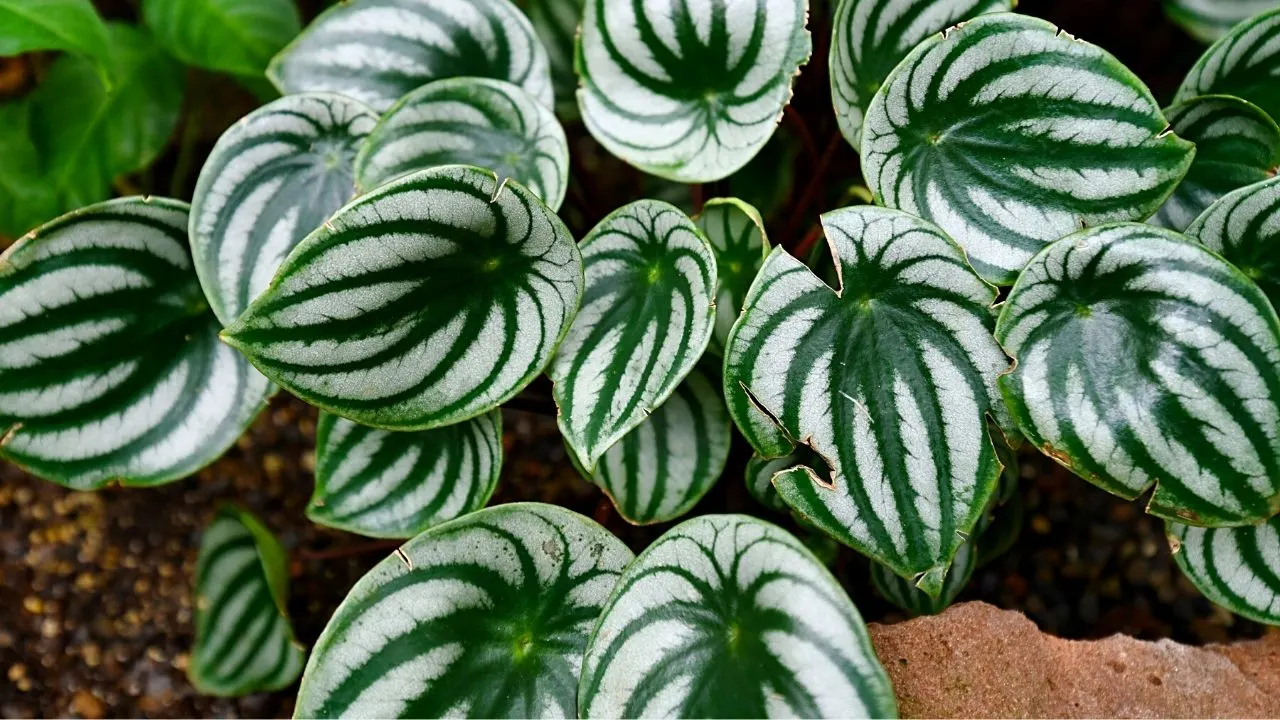
This plant is not related to watermelons, but the pattern on the foliage is similar to the one on watermelons. This small plant will grow in a rosette pattern creating a bushy potted plant.
Most growers admire this plant for the colorful leaves that glow under the sun.
Keep in mind this water-loving Peperomia needs plenty of moisture to grow healthy leaves.
- Family: Piperaceae
- Other names: Peperomia Argyreia, Watermelon Begonia
- Toxicity: non-toxic for your pets
- Lighting: shade with a few hours of filtered sunlight
- Temperature: 65 to 75 degrees Fahrenheit (18 to 24 degrees Celsius)
- Soil: peat and perlite soil
- pH: Acidic
- Fertilizer: once or twice a month in the spring season
- Growth rate: slow grower
- Humidity: average household humidity
20. Polka Dot Plant
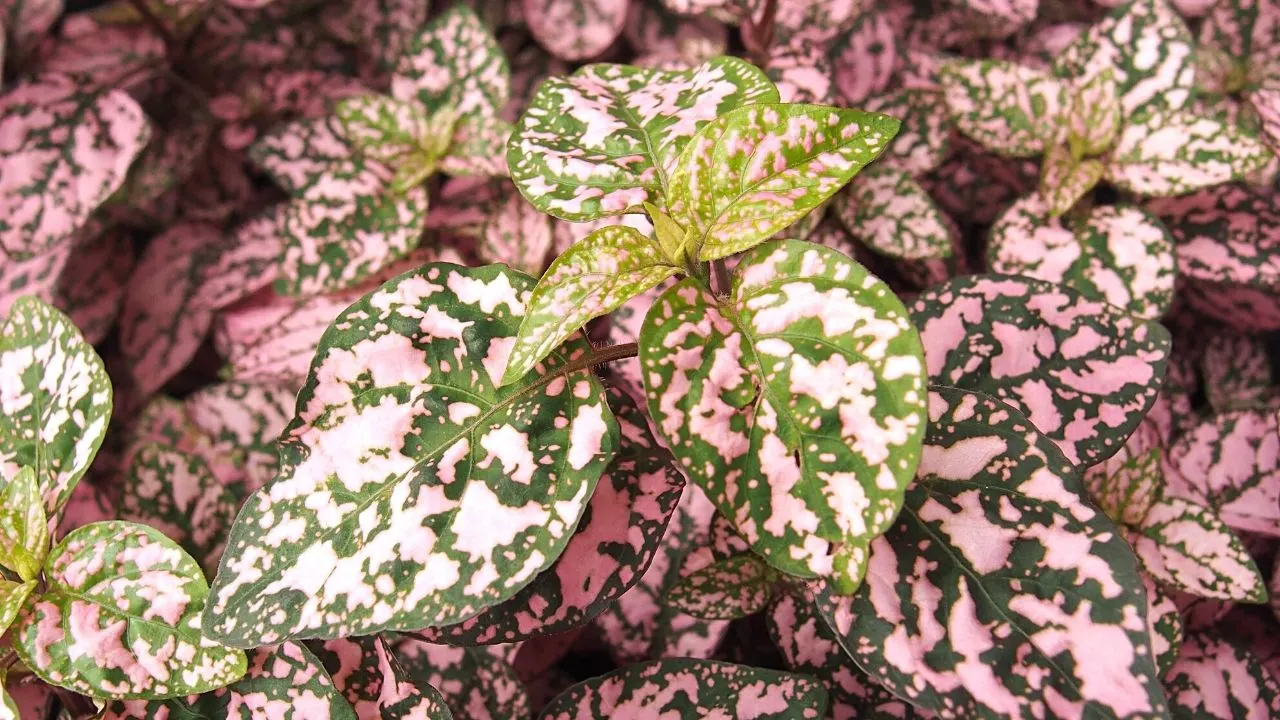
This compact plant has one of the most interesting-looking foliage in shades of pink, red, purple, and green. The variegated leaves are speckled with colorful markings.
Choosing the right light levels will help you in retaining the colorful variegation on this ornamental plant.
This eye-catching plant is easy to maintain as an indoor plant.
- Family: Acanthaceae
- Other names: Hypoestes Phyllostachya, Flamingo plant, or Pink Dot
- Toxicity: non-toxic for animals
- Lighting: partial sunlight
- Temperature: 70 to 75 degrees Fahrenheit (21 to 24 degrees Celsius)
- Soil: regular, organic potting soil with good drainage
- pH: 6.1-7.3
- Fertilizer: monthly in spring and summer
- Growth rate: moderate
- Humidity: at least 50% or higher
21. Youth on Age
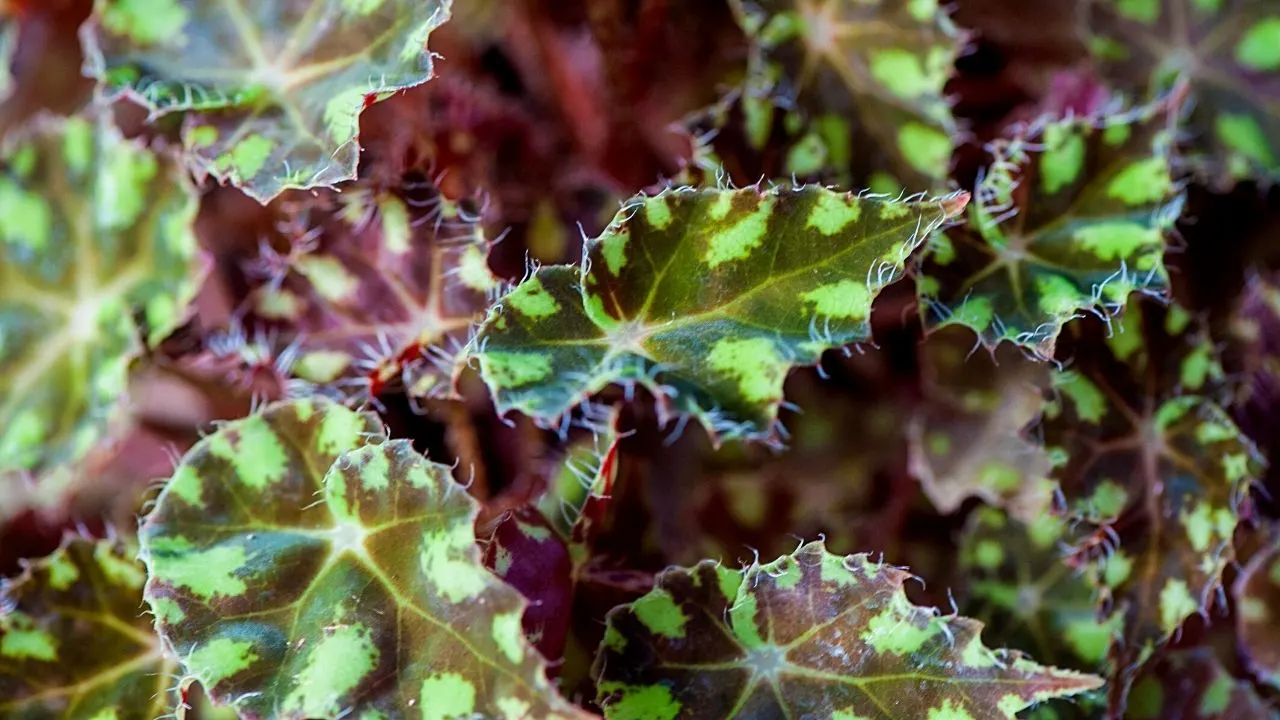
Unlike some other houseplants, this one will continue growing new foliage right in the center of the plant. The lush green leaves have a fuzzy texture.
This plant is not an easy one, and it needs certain growing conditions when planted indoors.
The most important care instruction is to keep it away from direct sun and heat.
- Family: Saxifragaceae
- Other names: Tolmiea Menziesii, Piggyback plant
- Toxicity: non-toxic
- Lighting: partial shade with filtered sunlight
- Temperature: 40 to 65 degrees Fahrenheit (4 to 18 degrees Celsius)
- Soil: loose, well-draining organic potting soil
- pH: 5.0 – 7.0
- Fertilizer: once a month with liquid fertilizer
- Growth rate: moderate or fast grower
- Humidity: high humidity
22. Purple Shamrock
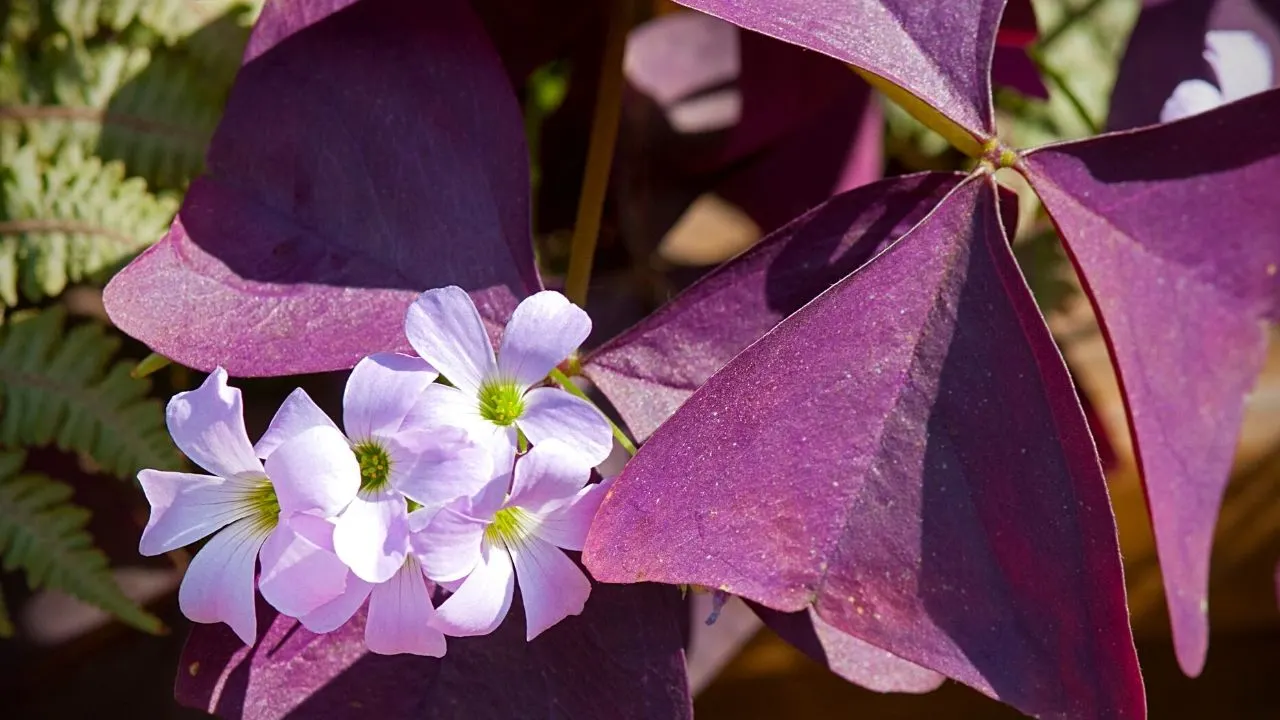
This perennial plant grows deep purple, triangular leaves in groups of three. The foliage will fold at night and reopen again in the morning.
The heart-shaped leaves give the impression of several butterflies clustered on a plant.
This plant will also produce small flowers in shades of pink, white or lavender in spring, autumn, and winter.
Purple Shamrock will go dormant during the hot summer months.
- Family: Oxalidaceae
- Other names: Purple Oxalis, False Shamrock
- Toxicity: toxic for pets and humans
- Lighting: full or partial sunlight
- Temperature: 60 to 75 degrees Fahrenheit (15 to 24 degrees Celsius)
- Soil: loamy soil
- pH: 7.5-8.0
- Fertilizer: liquid fertilizer during active seasons
- Growth rate: moderate
- Humidity: moderate (around 50%)
23. Boston Fern
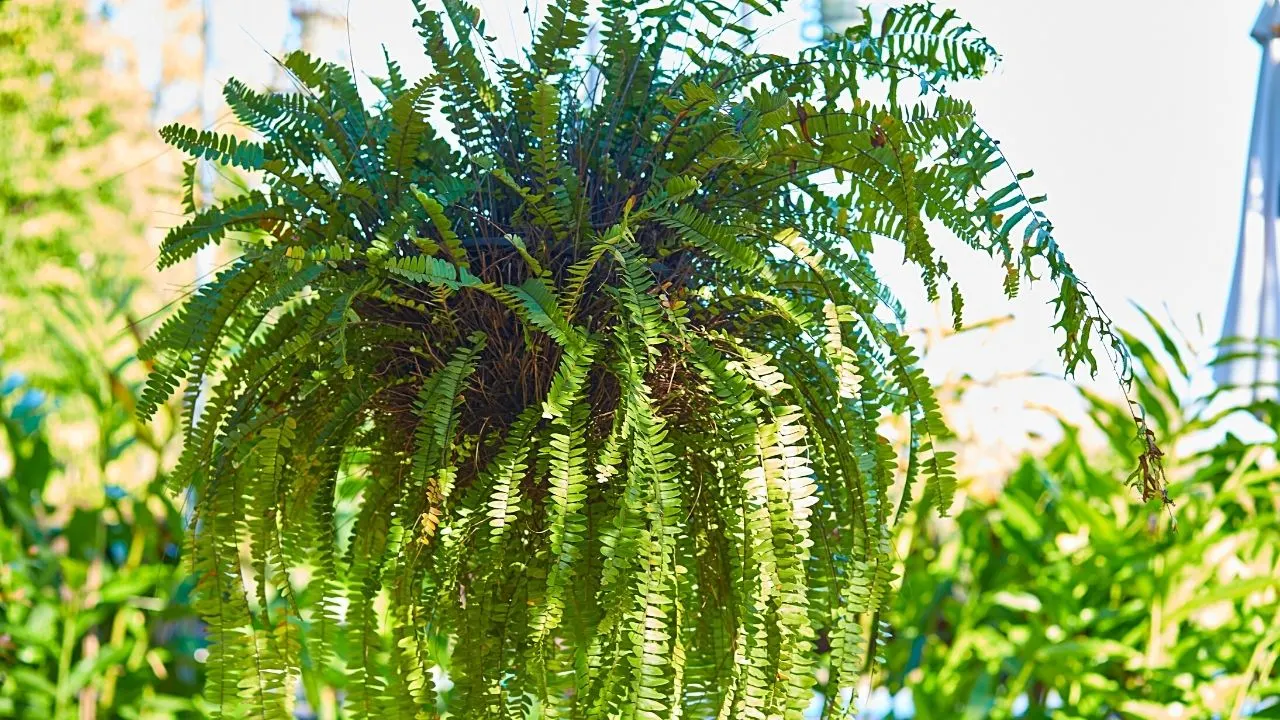
This is a must-have indoor plant for low to moderate light levels. The bluish-green leaves or fronds are sword-shaped and have air-purifying qualities.
This is not an invasive houseplant and thrives on minimal care, so simply let it hang in the corner of your east-facing window throughout the year.
Pruning this Fern regularly will help you get rid of leggy foliage and achieve a bushy plant.
- Family: Lomariopsidaceae
- Other names: Nephrolepis Exaltata, Sword Fern
- Toxicity: non-toxic for pets and humans
- Lighting: bright, filtered sunlight
- Temperature: 65 to 75 degrees Fahrenheit (18 to 24 degrees Celsius)
- Soil: loamy, rich soil with excellent drainage
- pH: 6.0 – 6.5
- Fertilizer: once a month in spring and summer
- Growth rate: slow grower
- Humidity: 50% or above
24. Croton Plants
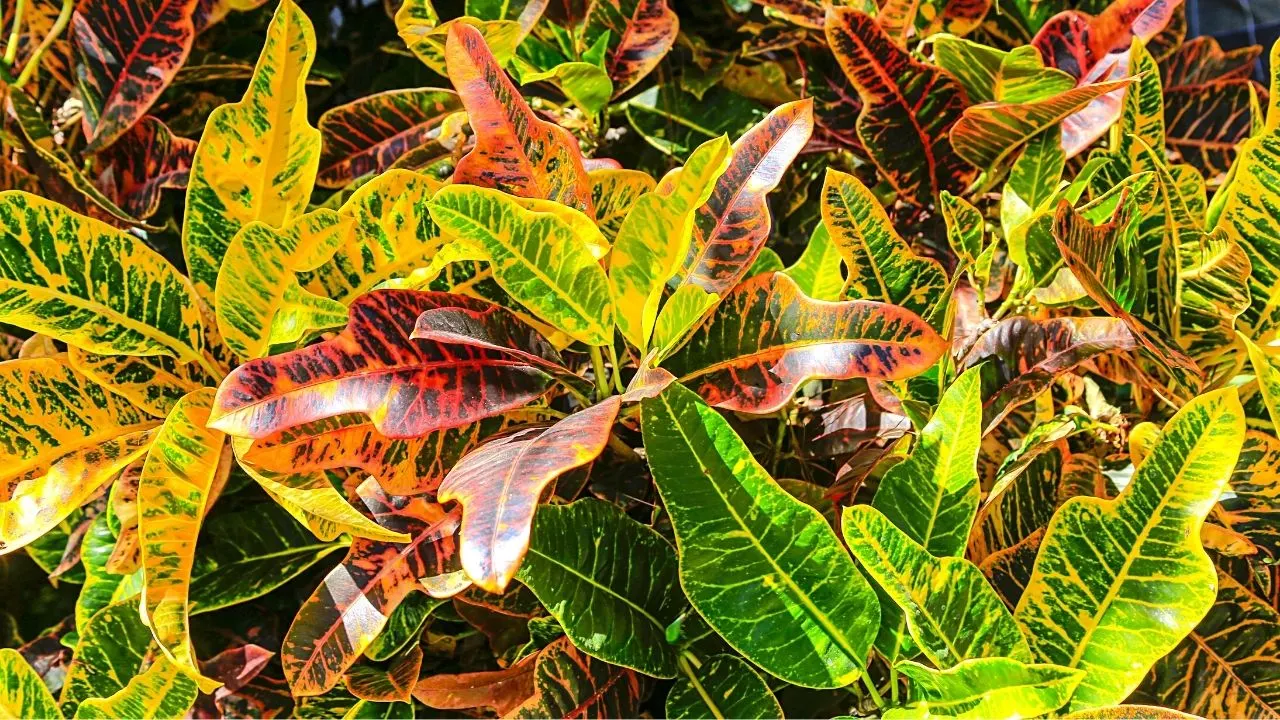
Crotons are splendid houseplants with variegated foliage in beautiful colors like scarlet, green, orange, and yellow. Both upper and lower leaf sides come in different shades and leaf-forms with splotches.
Make sure you wipe the foliage every few days to get rid of any dust particles accumulated on the surface.
Popular variants include Oakleaf, Gold star, Petra, and Eleanor Roosevelt. These plants hate cold weather.
Keep in mind that this plant is poisonous to your pets, so keep it at a high spot away from your kids or furry friends.
- Family: Euphorbiaceae
- Other names: Rushfoil, Codiaeum Variegatum
- Toxicity: toxic for humans and pets
- Lighting: sunny spots with bright but indirect light
- Temperature: 70 to 80 degrees Fahrenheit (21 to 27 degrees Celsius)
- Soil: peat-based soil with organic compost
- pH: 4.5 – 6.5
- Fertilizer: once a month during the growing season
- Growth rate: slow grower
- Humidity: at least 40% or above
25. Japanese Aralia
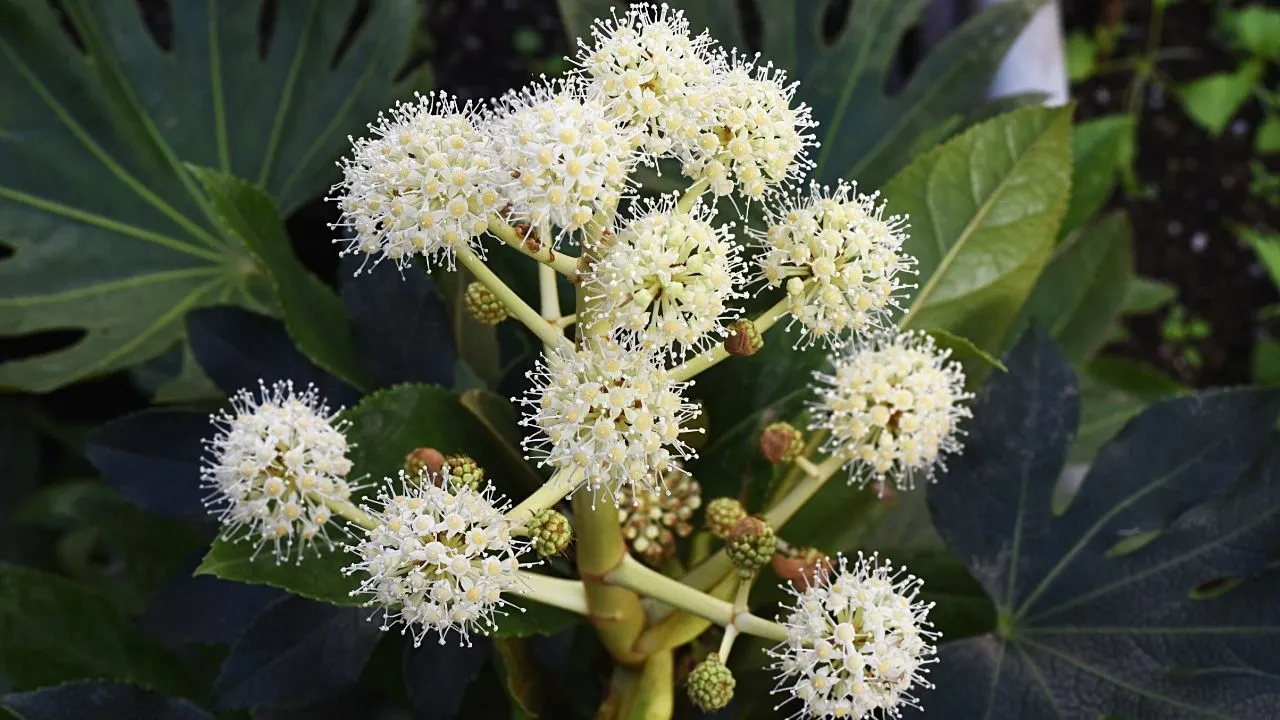
This plant is native to Japan, Taiwan, and Korea. It has beautiful, deeply lobed, green leaves and petioles and reaches a maximum height of 5 ft as an indoor plant.
You will also see it blooming during autumn with white flowers. This is a hardy houseplant with an easy-care schedule.
- Family: Araliaceae
- Other names: Fatsia Japonica, Paper Plant
- Toxicity: non-toxic to pets
- Lighting: Shade or partial sunlight
- Temperature: 60 to 70 degrees Fahrenheit (15 to 21 degrees Celsius)
- Soil: clayey or loamy soil
- pH: slightly acidic
- Fertilizer: apply liquid fertilizer during the growing season
- Growth rate: moderate
- Humidity: no specific humidity requirements
26. Wax Begonia
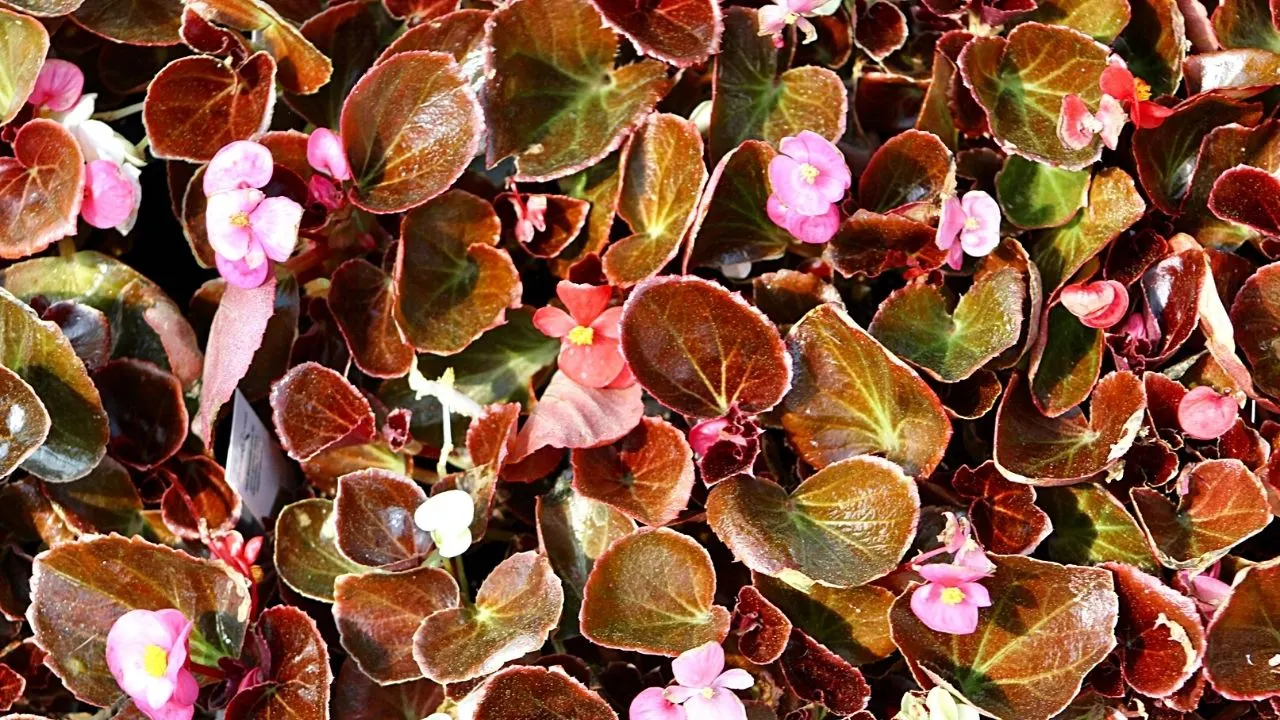
These flowering Begonia plants flaunt glossy leaves in maroon, green, and bronze. The summer blooms will be pink, white, or red.
This variety has gained immense popularity as a bedding plant for outdoor gardens in cold and warm climates, but you can also add it to your indoor plant collection.
When growing these Begonias as a container plant, make sure you choose a pot with at least one drainage hole.
- Family: Begoniaceae
- Other names: Begonia Semperflorens
- Toxicity: toxic for pets and humans
- Lighting: full sun but will also grow under partial shade
- Temperature: 60 to 75 degrees Fahrenheit (15 to 24 degrees Celsius).
- Soil: peat-based rich and well-draining potting soil
- pH: 5.5 – 6.5
- Fertilizer: does not require much feeding
- Growth rate: fast-growing
- Humidity: higher than 50%
27. Chinese Money Plant

This Chinese native plant has a unique flat but round leaves that look like coins. Each leaf has a tiny yellow dot in the middle where it attaches to the long stalks.
This is a popular window sill plant for beginners throughout the world and looks lovely in wooden baskets.
If you want these plants to bloom, you have to expose them to cold temperatures. But your plant needs to be mature to grow the white flowers on pink stalks.
- Family: Urticaceae
- Other names: Pilea Peperomioides, UFO plant, Missionary plant
- Toxicity: Non-toxic for pets
- Lighting: bright, filtered sunlight
- Temperature: 55 to 86 degrees Fahrenheit (13 to 30 degrees Celsius)
- Soil: regular potting soil with perlite
- pH: 6.0 – 7.0
- Fertilizer: feed monthly with all-purpose fertilizer during the active season
- Growth rate: fast grower
- Humidity: between 50-75%
28. Philodendron Pink Princess
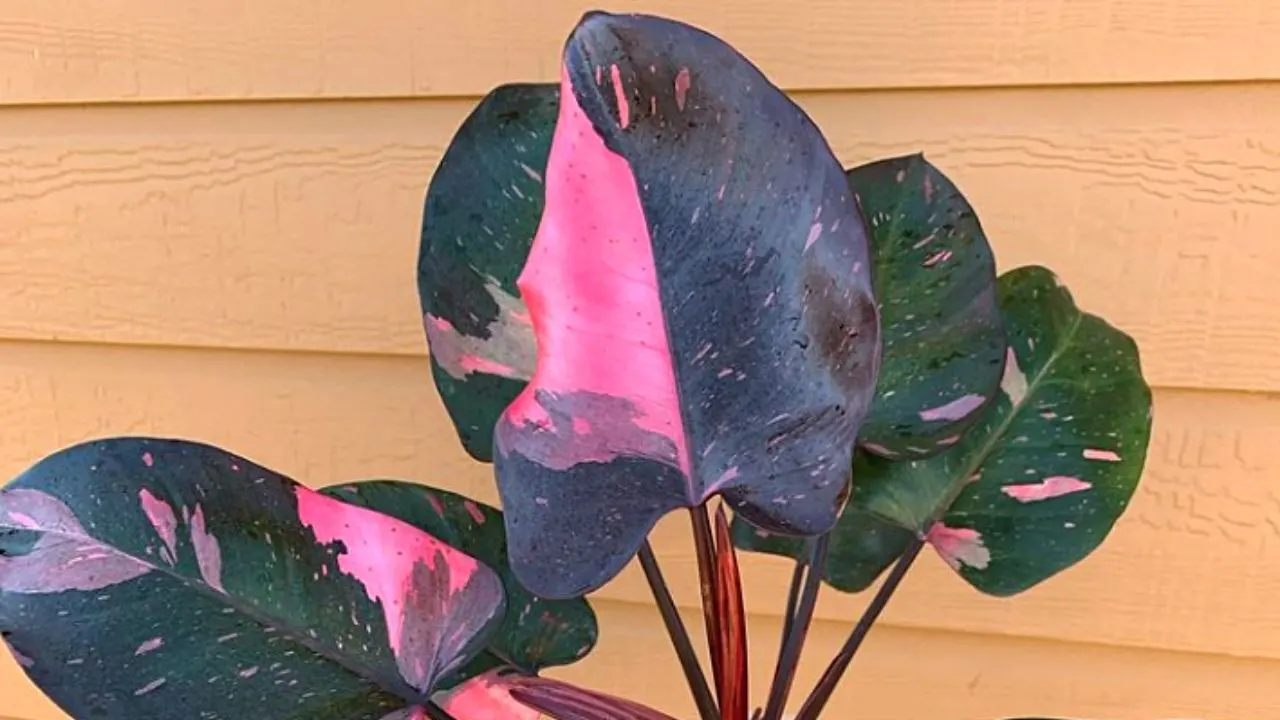
Photo Credit: @alextheplantnurse on Instagram!
The Philodendron Pink Princess will indeed look like a princess among other green houseplants with its pink and green variegated leaves. Each leaf is unique, making this plant a centerpiece for plant enthusiasts.
The combination of pink and green will stand out even if you group it with other foliar plants.
This variant has stable variegation; therefore, as long as you maintain the right conditions, your plant will not lose any color.
- Family: Araceae
- Other names: Blushing Philodendron, Philodendron Erubescens
- Toxicity: toxic for pets
- Lighting: partial sunlight
- Temperature: 65 to 80 degrees Fahrenheit (18 to 26 degrees Celsius)
- Soil: loamy soil that drains well
- pH: 5.0 – 7.0
- Fertilizer: once a month in the growing seasons of spring and summer
- Growth rate: fast grower
- Humidity: high levels (more than 50%)
29. Monstera adansonii
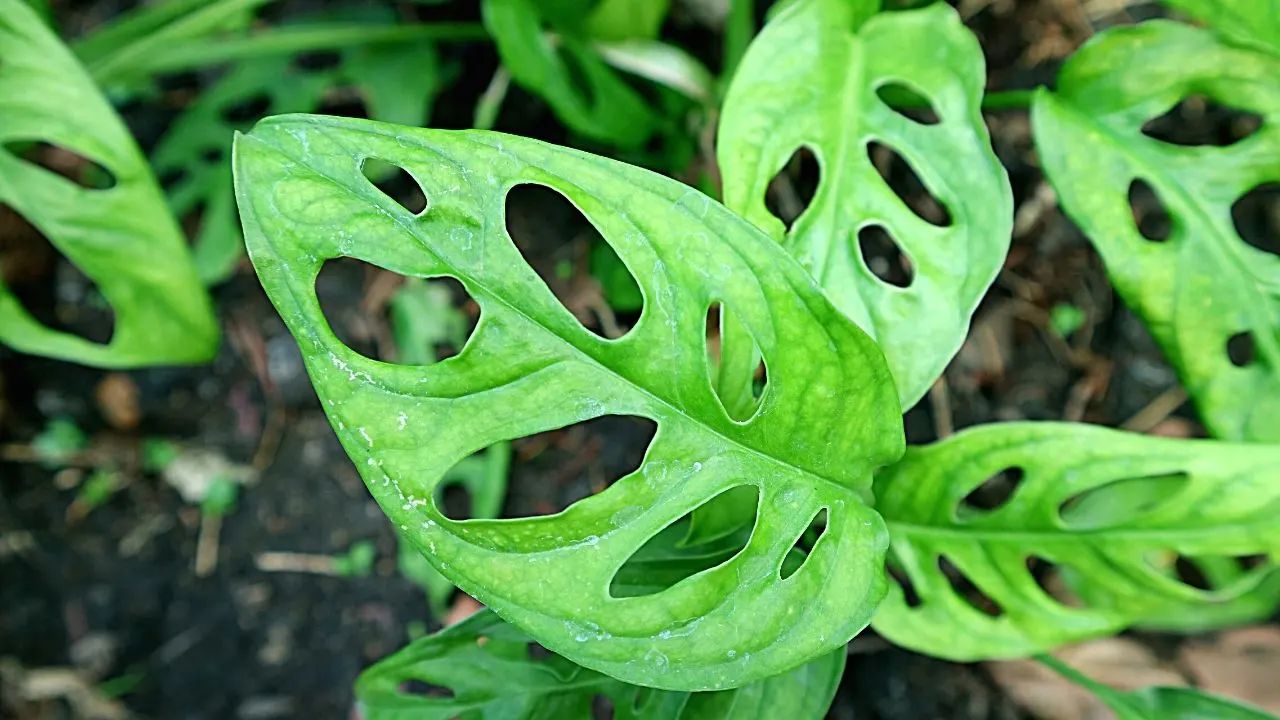
You can have as many Monstera as you like in your house. You might already own a variety of Swiss Cheese plants, and Monstera adansonii will be a great addition to your Monstera collection.
The large heart-shaped leaves will develop holes as the plant ages.
This plant has a vining growing habit and reaches a maximum size of 8 ft as an indoor plant.
- Family: Araceae
- Other names: Five Holes plant, Swiss Cheese plant
- Toxicity: toxic for pets
- Lighting: bright, filtered sunlight with one or two hours of direct sun
- Temperature: 65 to 80 degrees Fahrenheit (18 to 26 degrees Celsius)
- Soil: combine potting soil with orchid bark and coco chips
- pH: 5.5 – 7.0
- Fertilizer: once a month with diluted fertilizer
- Growth rate: fast grower
- Humidity: more than 50%
30. Rose Grape
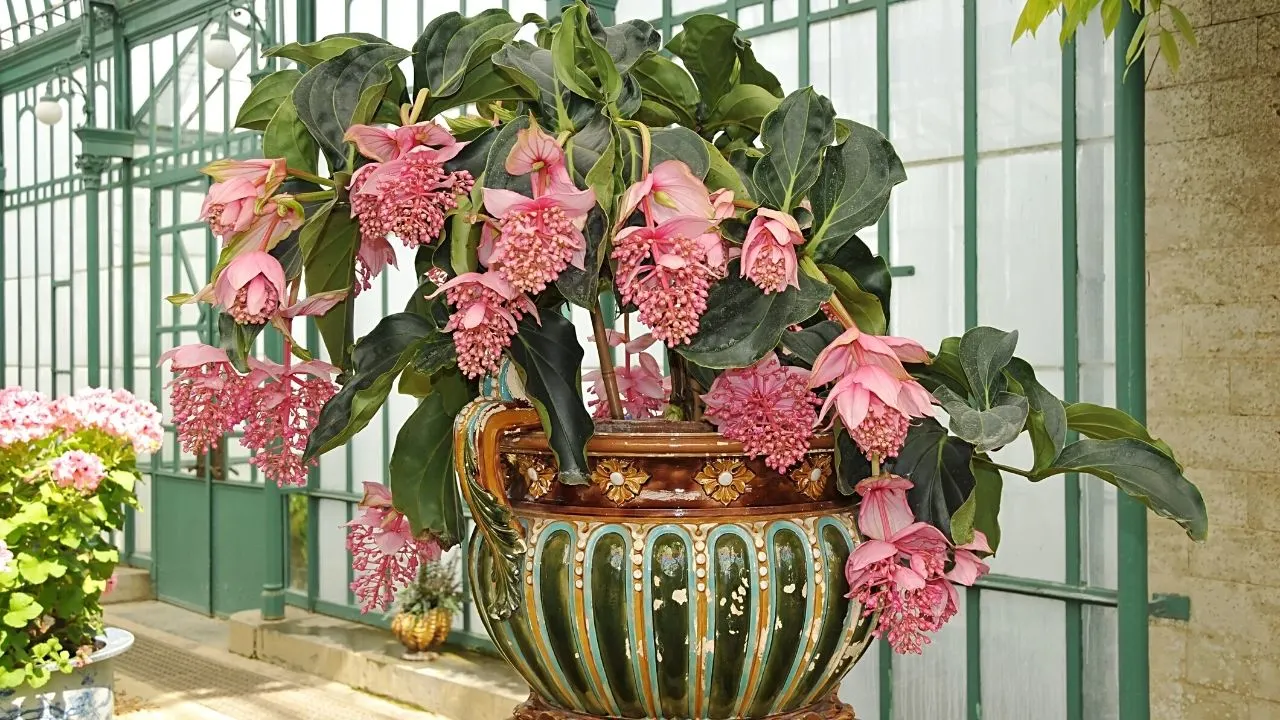
This plant is a must-have for anyone who loves large, fluffy blooms with a long blooming period.
The deep green leaves on this plant are equally beautiful, but most gardeners grow them for stunning pink flowers. This plant blooms throughout summer, and each flower lasts for about two months.
The leaves will reach a maximum length of 1 ft.
This is not an easy plant, so it’s only for people who are looking for some challenge in their indoor garden.
- Family: Melastomataceae
- Other names: Medinilla Magnifica
- Toxicity: non-toxic for pets and humans
- Lighting: bright, filtered light with morning sun
- Temperature: 65 to 80 degrees Fahrenheit (18 to 26 degrees Celsius)
- Soil: orchid mix
- pH: acidic
- Fertilizer: every two weeks in the summer
- Growth rate: fast grower
- Humidity: high humidity throughout the day
31. Jade Plant

The succulent, oval leaves on this plant grow closer to each other, giving it a compact appearance. Growers believe that this plant brings good luck to the house.
For the most part, the Jade plant is a low-maintenance plant, but you should be careful about excessive moisture since it makes the plant vulnerable to several diseases.
- Family: Crassulaceae or Stonecrop
- Other names: Crassula Ovata, Lucky plant
- Toxicity: all parts are toxic for pets
- Lighting: bright, filtered light (4-6 hours)
- Temperature: 65 to 70 degrees Fahrenheit (18 to 21 degrees Celsius)
- Soil: cactus potting soil mixed with perlite and sand
- pH: neutral or acidic
- Fertilizer: every week with a diluted liquid succulent fertilizer
- Growth rate: slow grower
- Humidity: at least 40%
32. Peace Lilies

The spathe-shaped white flowers complement the glossy green, textured foliage of the Peace Lilies.
They are considered an easy plant for the average household environment, and most people place them in the bathroom for high humidity.
I would suggest placing this plant in your bedroom or living room since it absorbs harmful toxins from the atmosphere. You can mist the leaves to fulfill the humidity requirements.
- Family: Araceae
- Other names: Spathiphyllum Wallisii, Closet plant
- Toxicity: toxic because of calcium oxalate
- Lighting: bright, indirect sunlight
- Temperature: 65 to 80 degrees Fahrenheit (18 to 26 degrees Celsius)
- Soil: potting mix with perlite, coco coir, and peat moss
- pH: acidic
- Fertilizer: add plant food every week in the summer
- Growth rate: moderate
- Humidity: 60% or above
33. Moth Orchid

The elegant flowers in a beautiful shade of pink will make sure your indoor space looks minimal but stylish. This makes a great flowering plant for new plant owners.
If you manage to keep the plant happy, it will reward you with long-lasting blooms in shades of pink, lavender, white, and even yellow.
Did you know that a single flowering branch on this plant can grow up to 20 flowers?
- Family: Orchidaceae
- Other names: Phalaenopsis Orchid
- Toxicity: non-toxic for pets
- Lighting: Shade or morning sun
- Temperature: 75 to 85 degrees Fahrenheit (24 to 29 degrees Celsius)
- Soil: custom mix with perlite, coconut husk, sphagnum moss
- pH: 5.5 – 6.5
- Fertilizer: only feed during summer
- Growth rate: moderate
- Humidity: between 50 to 80%
34. Norfolk Island Pine
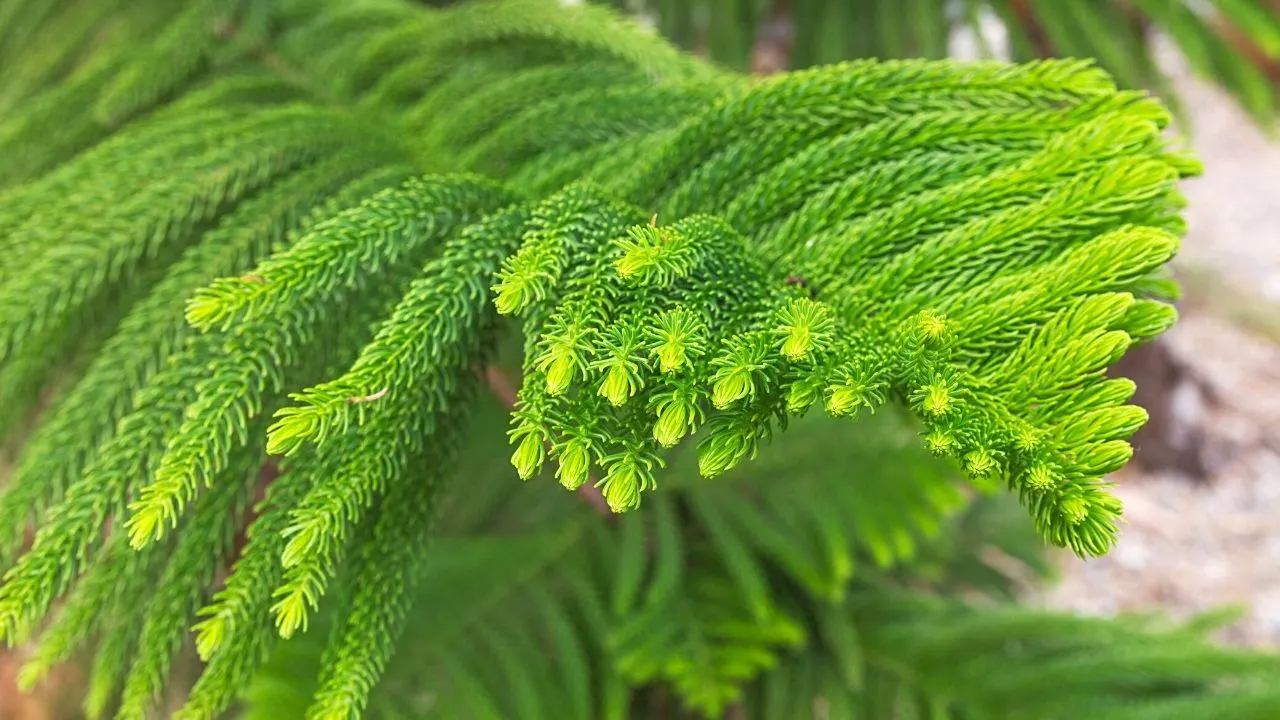
The Norfolk Island Pine adds a forest vibe with its pointed needle-like leaves. Some growers use it as a Christmas tree, but you can also keep it indoors year-round.
You can follow the care instructions given below and protect it from cold to keep this long-living plant thriving for several years.
- Family: Araucariaceae
- Other names: Araucaria Heterophylla, Australian Pine
- Toxicity: might be toxic for pets
- Lighting: can tolerate low light as well as bright light
- Temperature: 65 to 70 degrees Fahrenheit (18 to 21 degrees Celsius)
- Soil: peat-based, well-draining soil
- pH: 4.5 – 5.5
- Fertilizer: does not require much feeding
- Growth rate: slow grower
- Humidity: around 50%
35. Peony

Peonies will bloom from spring through summer, and you get to enjoy lush green foliage and colorful, fluffy flowers both indoors and outdoors.
You can also use the showy flowers to fill vases or gift them to a friend.
All these large blooms are scented, but the flowers’ colors will depend on what variety you’re growing.
- Family: Paeoniaceae
- Other names: Paeony, Paeonia Officinalis
- Toxicity: toxic for pets
- Lighting: partial shade or full sun
- Temperature: 65 to 70 degrees Fahrenheit (18 to 21 degrees Celsius)
- Soil: loamy, well-draining soil
- pH: 6.5 – 7.0
- Fertilizer: feed in spring with bulb fertilizer
- Growth rate: slow grower
- Humidity: moderate
36. Aechmea Fasciata
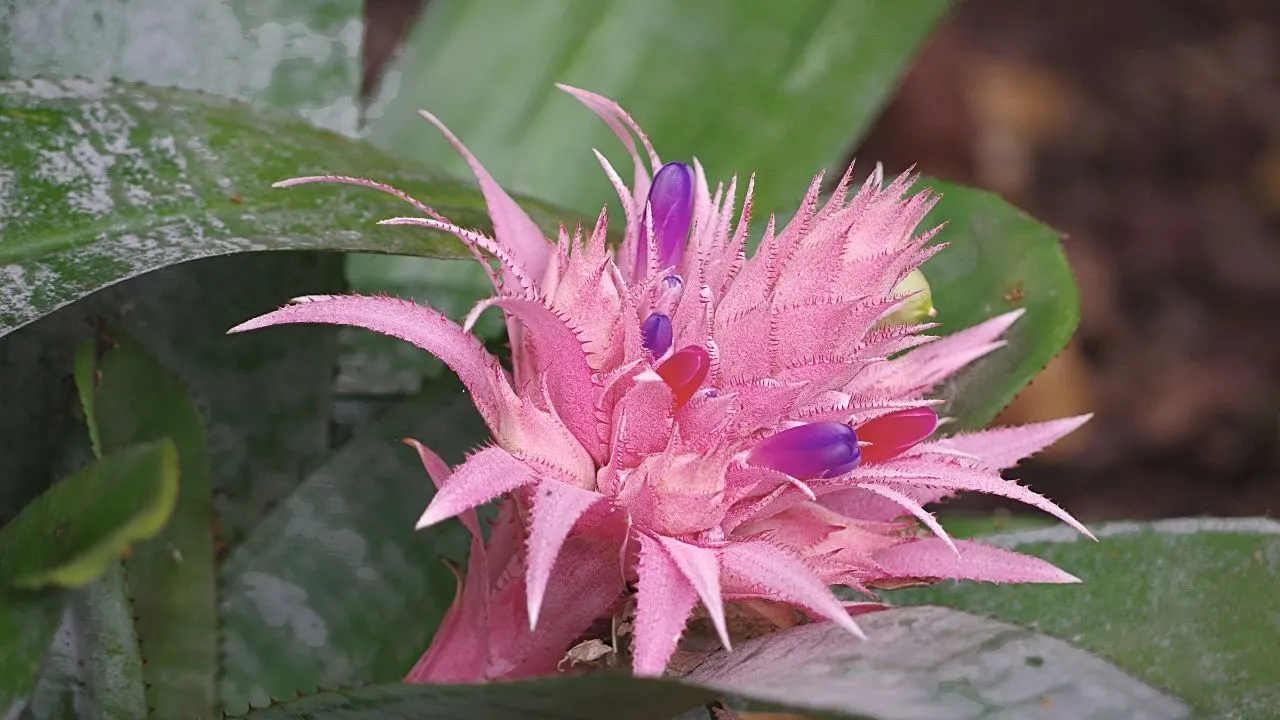
The green, arching leaves on this plant create a rosette with a large pink flower in the middle. This gives an urn-like look to the plant.
This plant should be kept under a bright light to help it bloom. Keep in mind Aechmea Faschiata will die once the bloom fades.
What makes this plant different in terms of watering from others is that the urn should be filled with water at all times to keep the plant moist and happy.
- Family: Bromeliaceae
- Other names: Urn Plant or Silver vase
- Toxicity: non-toxic but can cause skin irritation
- Lighting: bright light with direct morning sun
- Temperature: 65 to 75 degrees Fahrenheit (18 to 24 degrees Celsius)
- Soil: Orchid potting mixture
- pH: 6.1 – 6.5
- Fertilizer: feed once a month in spring and summer
- Growth rate: slow grower
- Humidity: around 50%
37. Calico Plant

This tender perennial produces pinkish green leaves, which are sensitive to direct, harsh afternoon sun. This evergreen plant will reach a maximum size of 18 inches.
It will also produce pompom-like tiny white blooms (about 1″ in size) in summer or early fall.
- Family: Aristolochiaceae
- Other names: Alternanthera Ficoidea, Calico weed
- Toxicity: non-toxic
- Lighting: partial shade or light
- Temperature: 60 to 75 degrees Fahrenheit (15 to 24 degrees Celsius)
- Soil: organic, well-draining soil
- pH: 5.6 – 6.5
- Fertilizer: feed once a month in spring and summer
- Growth rate: fast-growing
- Humidity: average room humidity
38. Caladium
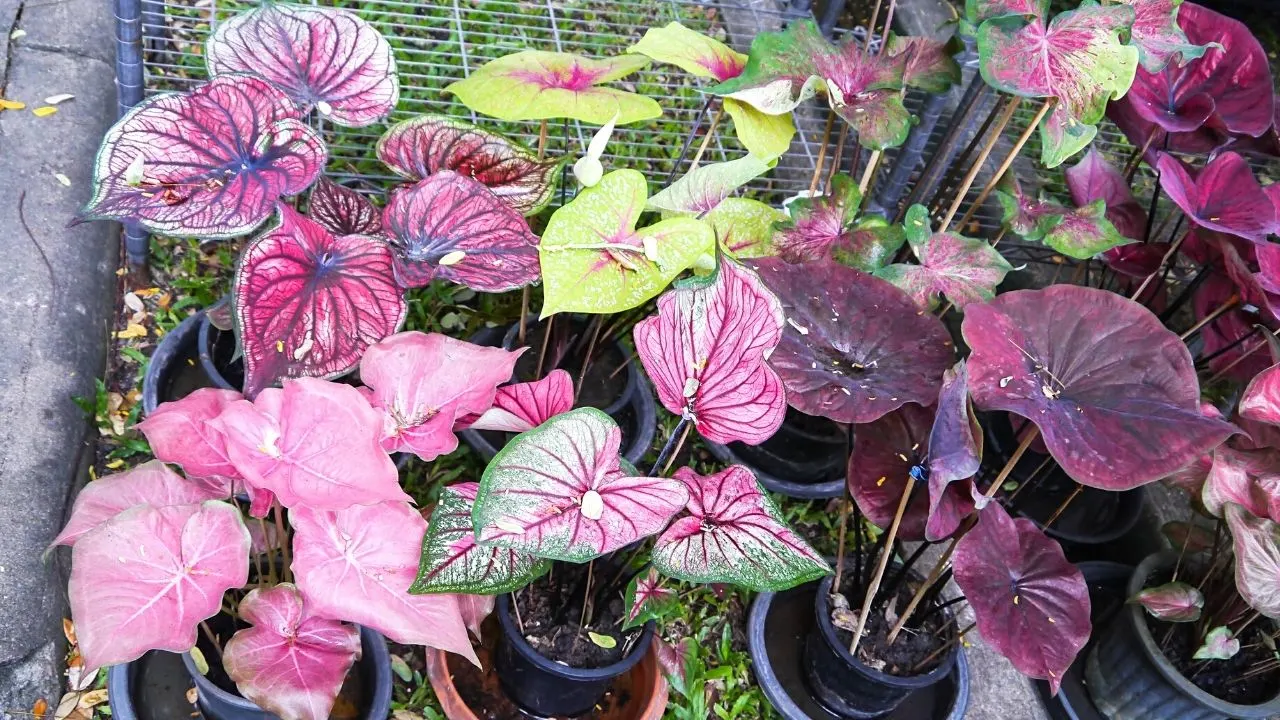
These houseplants are available in striking combinations of pink, red, green, and white. You can select from a fancy-leafed or a strap-leafed variety.
Most varieties will reach a maximum size of 24 inches, but the dwarf versions will grow up to 12 inches only.
These heat-loving plants will thrive in your bathroom or sunrooms when grown indoors.
- Family: Araceae
- Other names: Angel Wings, Elephant Ear
- Toxicity: poisonous for pets and humans
- Lighting: bright, filtered sunlight (at least 4 hours)
- Temperature: 70 to 85 degrees Fahrenheit (21 to 29 degrees Celsius)
- Soil: combine regular potting soil with peat
- pH: slightly acidic
- Fertilizer: does not need much feeding but apply a light dose every two weeks
- Growth rate: slow grower
- Humidity: loves high humidity
39. Grape Ivy
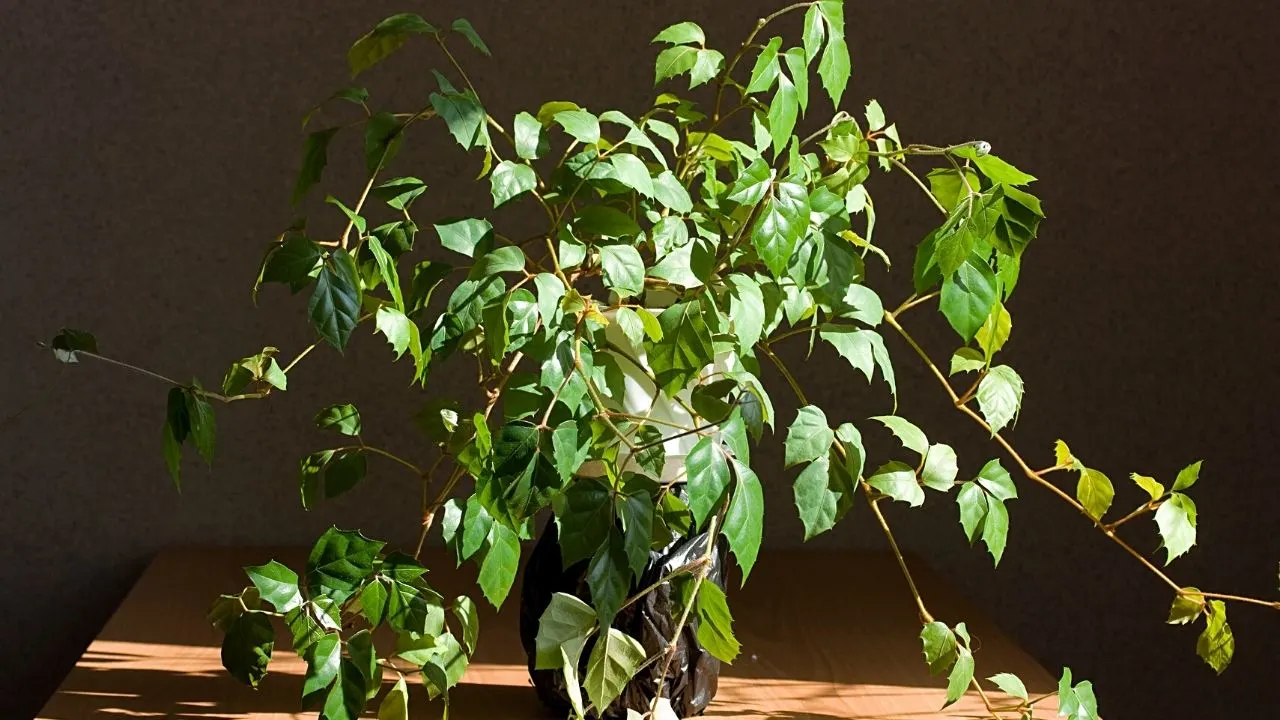
This is a popular indoor vining plant with long green vines. It’s best to hang it in the window and let the vines fall downwards.
There are several other ornamental vines, but this variety can easily adjust to the indoor growing conditions, and it does not require support to climb.
- Family: Vitaceae
- Other names: Cissus Rhombifolia, Oak Leaf Ivy
- Toxicity: non-toxic to humans and pets
- Lighting: partial shade
- Temperature: 68 to 82 degrees Fahrenheit (16 to 28 degrees Celsius)
- Soil: use peat moss, perlite, and bark
- pH: neutral or acidic
- Fertilizer: use a diluted liquid fertilizer in the growing season only
- Growth rate: slow grower
- Humidity: medium
40. Azaleas
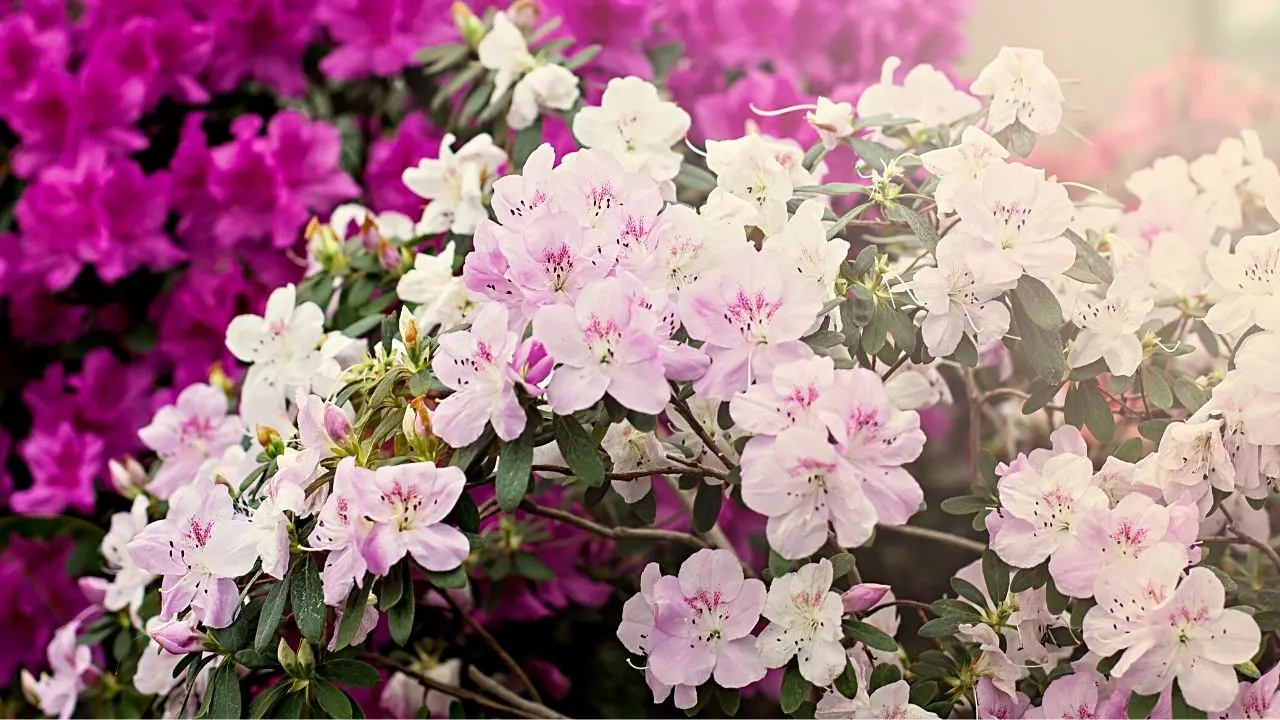
You might have noticed these colorful blooming plants in an outdoor setting, but the dwarf varieties can be used for indoor container gardening. These varieties reach a maximum size of 3 ft.
The branches on these plants are loosely spaced with elongated green foliage.
Azaleas come in a wide range of colors, so you can select whatever fits your liking but make sure you buy the greenhouse Azaleas.
- Family: Ericaceae
- Other names: Rhododendron
- Toxicity: toxic for humans and pets
- Lighting: partial shade with a few hours of morning sunlight
- Temperature: 60 to 65 degrees Fahrenheit ( 16 to 18 degrees Celsius)
- Soil: mix perlite, sphagnum moss, and compost
- pH: 4.5 – 6.0
- Fertilizer: feed in late winter and early spring with a complete houseplant fertilizer
- Growth rate: slow-growing
- Humidity: at least 40%
41. Campanula
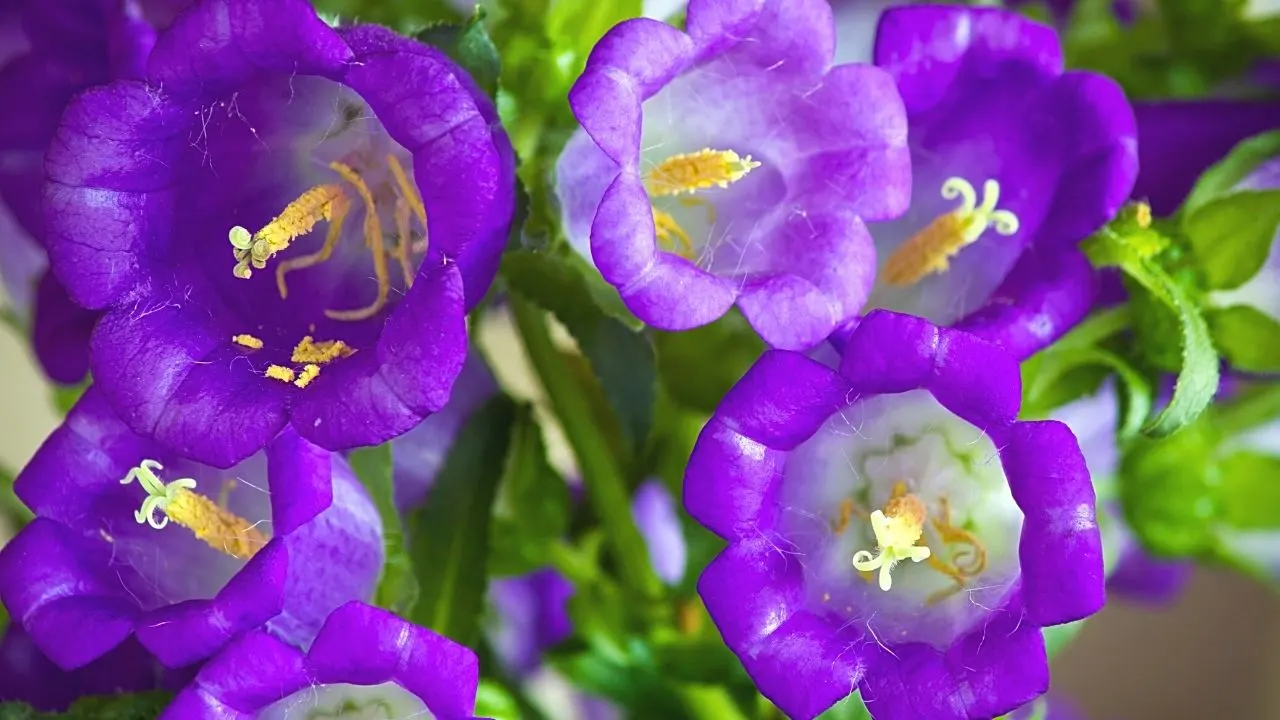
With about 500 species, these plants grow clusters of bell-shaped flowers in shades of purple, blue, and white. You can mix different varieties to have a multicolor display of flowers.
You can hang these in the window or place them on a table for a splash of colors. Each flower lives for about ten days.
A pro tip is to get rid of the wilted blooms if you want the plant to bloom for a long period.
Three common varieties for indoor container gardening are Star of Bethlehem, Italian Bellflower, and Wall Bellflower.
- Family: Campanulaceae
- Other names: Bellflowers
- Toxicity: non-toxic for pets and humans
- Lighting: partial shade or full sun
- Temperature: 28 to 78 degrees Fahrenheit (2 to 25 degrees Celsius)
- Soil: well-draining soil with compost
- pH: 6.0 – 8.0
- Fertilizer: feed every two weeks during active growth
- Growth rate: moderate
- Humidity: average household humidity
42. Soft Tip Yucca
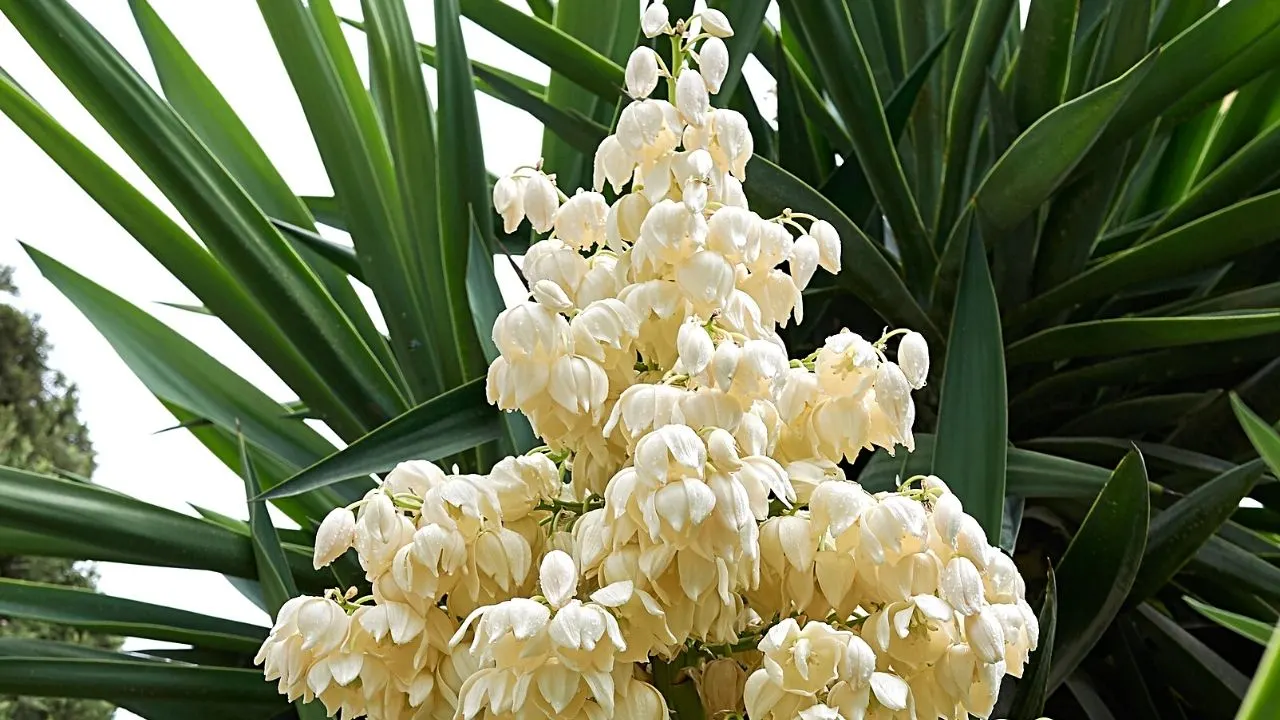
This plant features a thick grey stalk with green sword-shaped foliage. This variety has softer leaves compared to other plants in this family, which makes it a great indoor plant for homes with kids.
If you maintain the right environment, your yucca plant will bloom in spring or summer. It grows clusters of bell-shaped white flowers.
An indoor Yucca plant will reach a maximum height of 5 ft.
- Family: Asparagus
- Other names: Yucca Gigantea, Spineless Yucca
- Toxicity: toxic for pets
- Lighting: shade or full sun
- Temperature: 65 to 75 degrees Fahrenheit (18 to 24 degrees Celsius)
- Soil: poor, sandy soil mix with good drainage
- pH: slightly acidic
- Fertilizer: does not require regular feeding
- Growth rate: Slow grower
- Humidity: moderate
43. African Violets
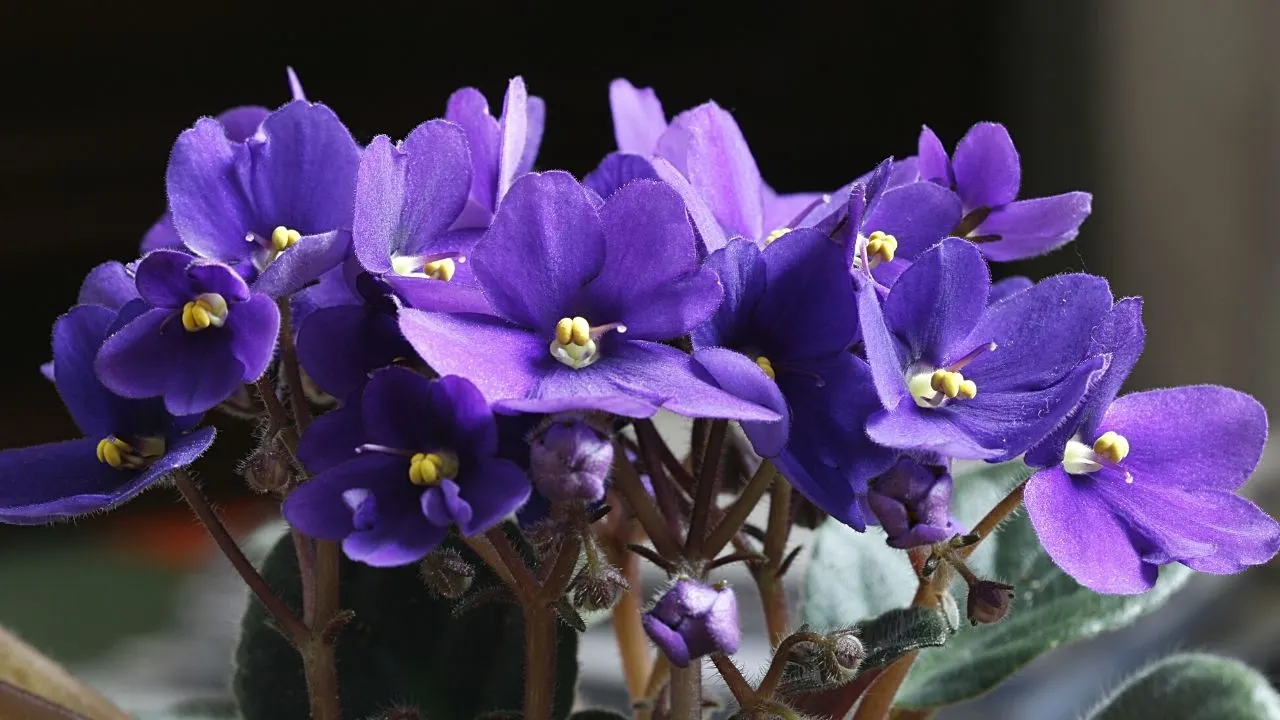
There are endless options when it comes to choosing flowering species for your living room or bedroom.
African Violets is a colorful plant species that require a bit of care if you want to keep it thriving indoors.
These plants not only grow cheerful flowers but also take up very less space indoors.
- Family: Gesneriaceae
- Other names: Saintpaulia Ionantha
- Toxicity: non-toxic
- Lighting: medium to bright, indirect sunlight
- Temperature: 65 to 80 degrees Fahrenheit (18 to 26 degrees Celsius)
- Soil: combine peat moss, perlite, vermiculite or use a commercial African violet mix
- pH: 5.8 -6.2
- Fertilizer: feed them with African Violet fertilizer
- Growth rate: usually slow-growing
- Humidity: 50 to 80%
44. Cyanotis Kewensis
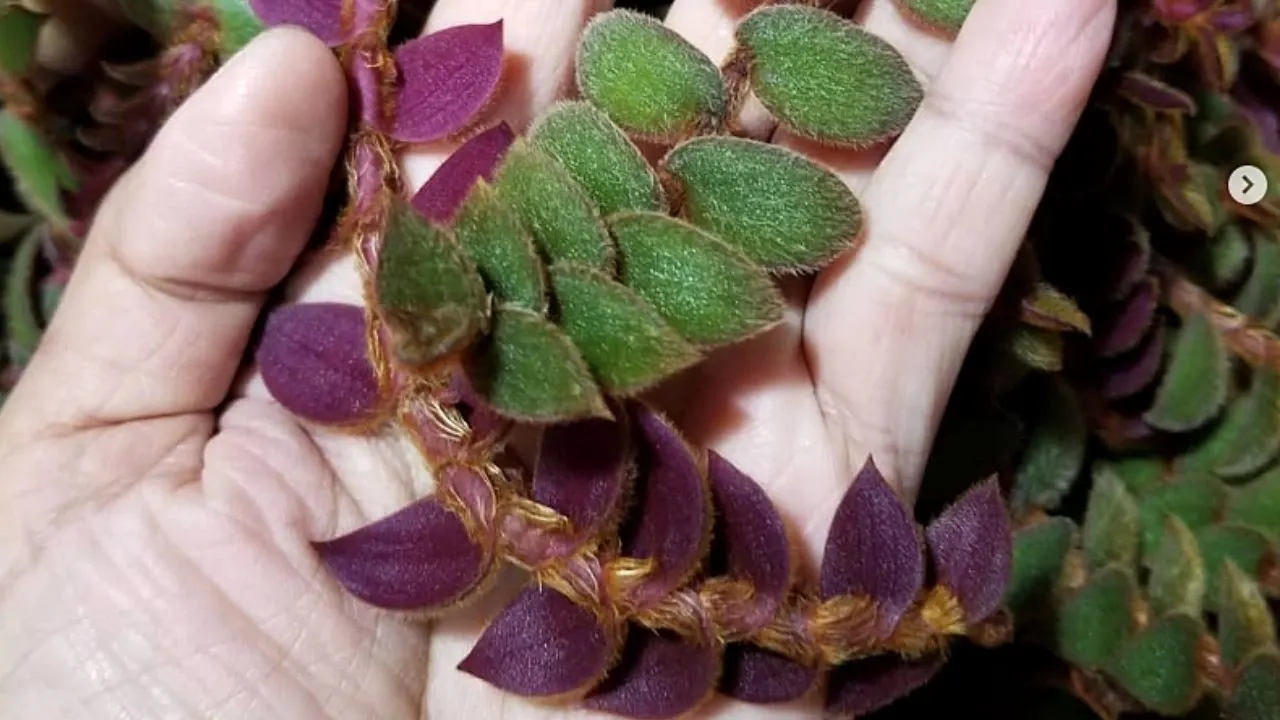
Photo Credit: @amanda.panda.sr on Instagram
The teardrop-shaped foliage on this vining plant is dark brown with a fuzzy texture. These vines look great in a wooden hanging basket.
This variety will also grow tiny mauve flowers in spring and summer.
- Family: Commelinaceae
- Other names: Teddy Bear Vine
- Toxicity: non-toxic for pets
- Lighting: loves morning sunlight
- Temperature: 60 to 80 degrees Fahrenheit (115 to 26 degrees Celsius)
- Soil: well-draining organic mix
- pH: acidic or neutral
- Fertilizer: feed it every two months during the growing period
- Growth rate: slow-growing
- Humidity: likes high humidity
45. Cissus Striata
This evergreen climber has palmate green leaves. Each leaf has 3 or 5 lobes with a leathery texture.
These vines will also produce green blooms in the summer season. It will take at least ten years to reach the maximum size.
- Family: Vitaceae
- Other names: Ivy of Uruguay, Miniature Grape Ivy
- Toxicity: non-toxic for pets
- Lighting: partial shade or full sun
- Temperature: 65 to 75 degrees Fahrenheit (18 to 26 degrees Celsius)
- Soil: amend potting soil with perlite or sand for good drainage
- pH: acidic or slightly alkaline
- Fertilizer: feed once a month with a balanced liquid plant food
- Growth rate: moderate or fast
- Humidity: around 40-60%
46. PocketBook Plant
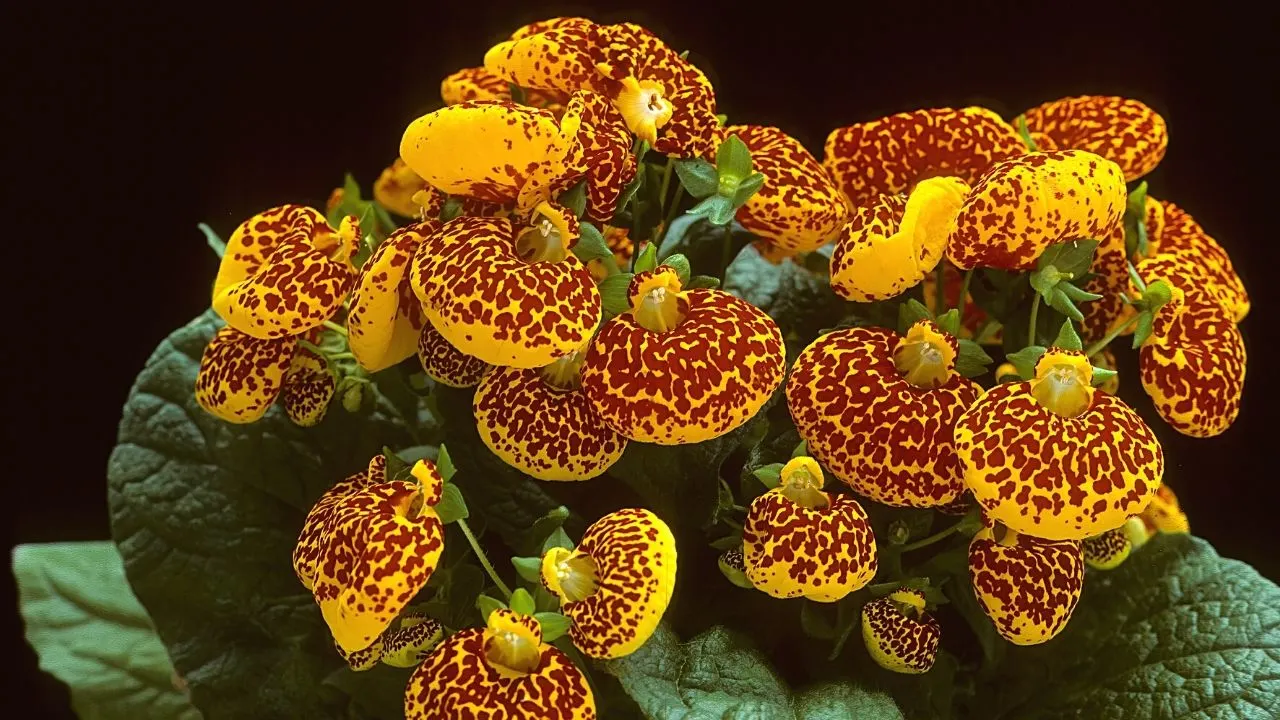
This plant is named after the pouches on the bright yellow and red flowers. The flowers rest on top of the large green leaves.
This is a great desk plant for cold-weather areas with minimal light.
- Family: Calceolariaceae
- Other names: Calceolaria, Slipper Flower
- Toxicity: toxic for pets
- Lighting: bright but indirect sunlight
- Temperature: 45 to 50 degrees Fahrenheit (7 to 10 degrees Celsius)
- Soil: peat-based soil mix
- pH: slightly acidic or neutral
- Fertilizer: does not require much feeding if the soil is rich
- Growth rate: moderate
- Humidity: medium humidity levels
47. Cast Iron Plant
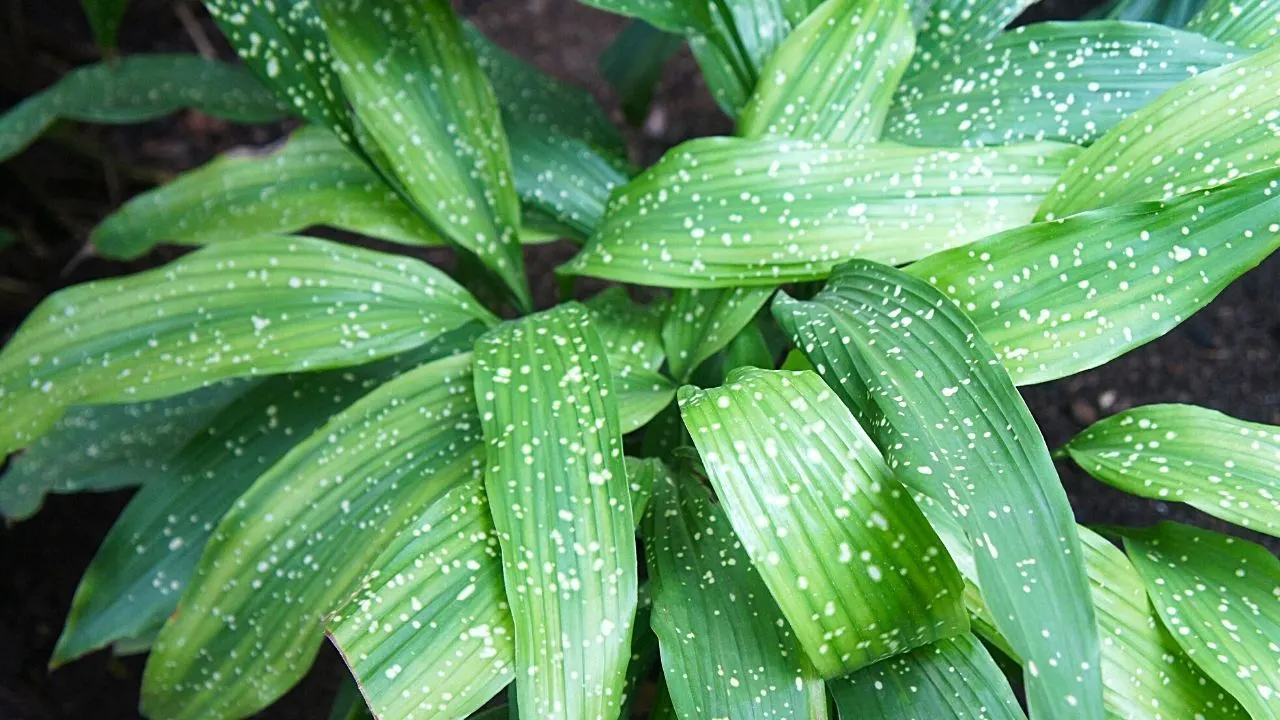
This hardy houseplant has beautiful pointy green leaves, and if you struggle with keeping your plants alive, you definitely need this one.
The Cast Iron Plant does not demand a lot of time and effort from its plant owner when grown as an indoor or outdoor plant.
The lance-shaped foliage can reach a maximum length of 2 ft.
- Family: Asparagaceae
- Other names: Barroom plant, Aspidistra Elatior
- Toxicity: non-toxic for pets
- Lighting: low light or partial shade
- Temperature: 60 to 75 degrees Fahrenheit (15 to 24 degrees Celsius)
- Soil: usual potting mix with good drainage
- pH: acidic or neutral
- Fertilizer: once a month when growing actively
- Growth rate: slow grower
- Humidity: medium humidity
48. Fire Flash

This trendy houseplant has orange stems with green foliage. This is a fairly new plant in the horticulture world, but the striking color combination is helping it become a favorite.
Indoor variants reach a maximum size of 12 inches.
- Family: Asparagaceae
- Other names: Orange Spider plant, Chlorophytum Orchidastrum
- Toxicity: safe for pets
- Lighting: partially shaded spots
- Temperature: 65 to 85 degrees Fahrenheit (18 to 26 degrees Celsius)
- Soil: regular potting soil with good drainage
- pH: 6.0 – 7.0
- Fertilizer: feed it once every three months
- Growth rate: fast-growing
- Humidity: around 50%
49. Baby’s Tears Plant
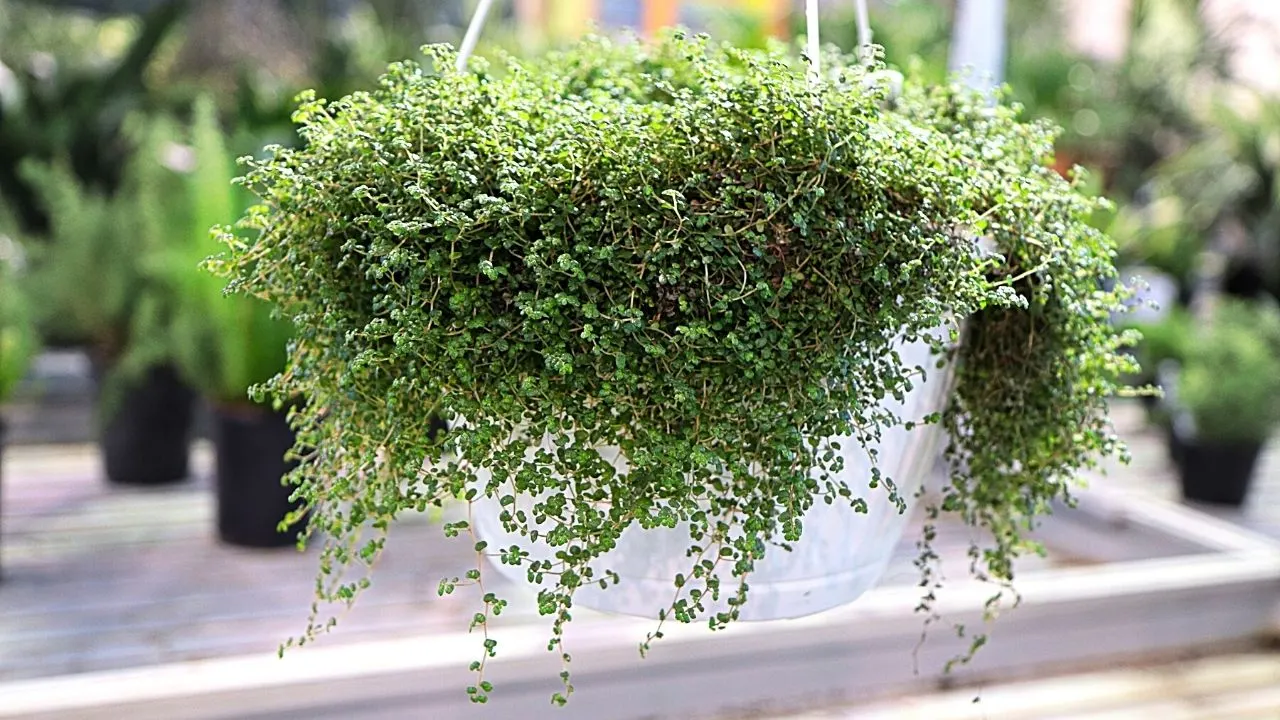
This low-light tolerating plant creates a mat of tiny, round leaves. This plant has a dense look with tightly packed leaves and short stems.
Remember that this is an invasive houseplant when grown in warm climates.
The ideal position is to hang this creeping variety in an east-facing window.
- Family: Urticaceae
- Other names: Soleirolia Soleirolii
- Toxicity: non-toxic
- Lighting: partial shade or partial sunlight
- Temperature: 50 to 70 degrees Fahrenheit (10 to 21 degrees Celsius)
- Soil: well-draining, rich potting soil with peat moss
- pH: 5.0 – 6.0
- Fertilizer: twice a month in spring and summer
- Growth rate: fast grower
- Humidity: 75% or higher
50. Rainbow Vine
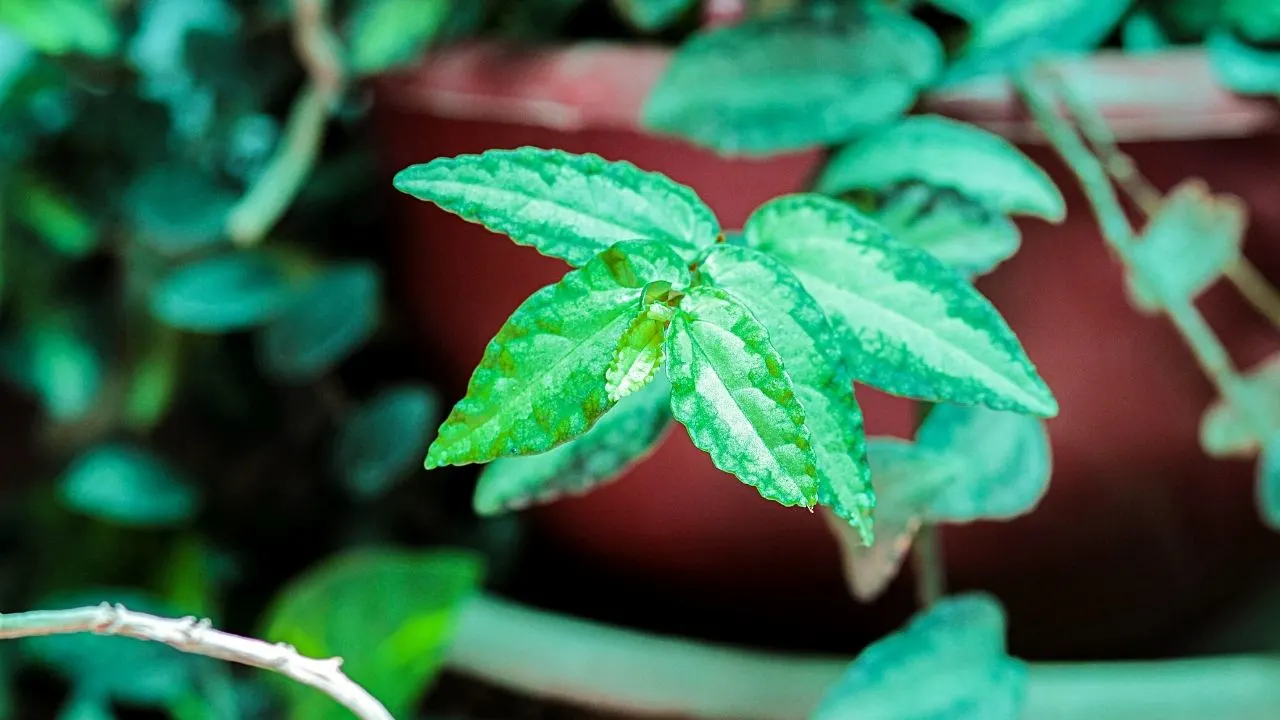
This creeping plant has dual-colored foliage where the outer edges of the leaves are deep green, and the middle is variegated in shades of light green and silver.
If you leave this plant under bright light, the foliage develops a maroon tint.
- Family: Urticaceae
- Other names: Pellionia Daveauana, Trailing Watermelon Begonia
- Toxicity: non-toxic for pets
- Lighting: bright, filtered light with morning sun
- Temperature: 40 to 80 degrees Fahrenheit (4 to 26 degrees Celsius)
- Soil: regular potting mix with excellent drainage
- pH: 6.0 – 7.5
- Fertilizer: needs light feeding during the growing season
- Growth rate: moderate
- Humidity: high humidity

Daniel has been a plant enthusiast for over 20 years. He owns hundreds of houseplants and prepares for the chili growing seasons yearly with great anticipation. His favorite plants are plant species in the Araceae family, such as Monstera, Philodendron, and Anthurium. He also loves gardening and is growing hot peppers, tomatoes, and many more vegetables.

![50 Best Plants for East-Facing Windows [2024]](https://plantophiles.com/wp-content/uploads/2020/08/15-Best-Plants-for-East-Facing-Windows-Featured-Image-480x270.png.webp)
